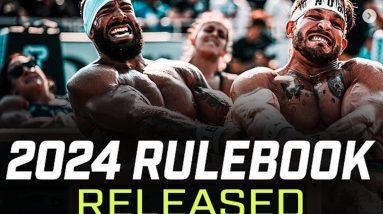
Key Insights from the 2024 CrossFit Season Competition: A Must-Read for Fitness Enthusiasts
The 2024 CrossFit season is fast approaching. The 2024 CrossFit Open will begin on Feb. 29, 2024, and the dates and locations for the 2024 CrossFit Semifinals are already known.
So, what should participating athletes in the 2024 CrossFit season know to prepare for success? Well, the 2024 CrossFit Games Competition Rulebook was released on Dec. 21, 2024. While most of it was standard operating procedure in line with the past couple of years, there were some notable items to be aware of.
View this post on InstagramA post shared by CrossFit Games (@crossfitgames)
[Related: Two-Time CrossFit Games Winner Justin Medeiros Entered a Powerlifting Competition and Totaled Over 1,400 Pounds]
2024 CrossFit Games Competition Rulebook
Below are four key takeaways from the 2024 CrossFit Games Competition Rulebook, courtesy of information provided by Morning Chalk Up managing editor, Joe Genetin-Pilawa:
1. No Title Sponsor Listed
“In previous years, the Games title sponsor (most recently NOBULL) appeared on the rulebook cover and throughout [its pages],” Genetin-Pilawa says. He explains that the absence of a title sponsor on the 2024 CrossFit Games Competition Rulebook suggests that a title sponsor has not been officially confirmed, noting that NOBULL’s contract with CrossFit expires at the end of 2023.
2. Important Changes to Athlete Eligibility Rules
Athlete eligibility for each stage of the competition is receiving a small facelift.
“For example, athletes who receive an exemption to compete in a region outside their country of citizenship are now required to re-apply each year — the exemption doesn’t carry over,” Genetin-Pilawa says.
Outside partners will organize all seven Semifinal events. However, CrossFit will continue to program the tests, manage scoring, and determine invitations, according to Genetin-Pilawa. The total number of competitors at each Semifinal has been standardized; every Semifinal will feature 40 Individual men, 40 Individual women, and 30 Teams (Rule 3.02).
View this post on InstagramA post shared by CrossFit Games (@crossfitgames)
There are other athlete eligibility rules that participating athletes should be aware of. The above is one example, Genetin-Pilawa explains, but competitors who expect to advance past the Open should prioritize the time to read the eligibility rules further.
3. Important Video Submissions and Judging Rule Changes
One example of changes to the rules is a revision to the “major penalty” category for video submissions, according to Genetin-Pilawa. Previously, a “major penalty” was a flat 15-percent score adjustment. However, in 2024, that adjustment can be “15 to 40 percent,” depending on the severity of the violation (Rule 1.22).
There are other adjustments like this to judging and video submissions. Participating 2024 CrossFit season athletes should familiarize themselves with the adjustments to avoid being surprised should they encounter one or more of them.
4. Be Aware of Appendix D
“With a significant portion of the Games season occurring virtually, CrossFit has added a set of ‘Virtual Competition Guidelines,’” Genetin-Pilawa says. “These guidelines include setup considerations, video submission requirements and penalties, an outline of best practices, and a table of standard weight conversions between pounds and kilograms.”
Genetin-Pilawa explains that this is a welcome addition as more specificity and clarity of such information is usually a boon for athletes and one that he says athletes should examine closely.
For a detailed breakdown of more changes to the 2024 CrossFit rulebook, head here.
Featured image: @crossfitgames on Instagram
The post 4 Takeaways From the 2024 CrossFit Season Competition Rulebook appeared first on BarBend.
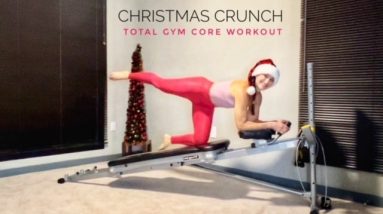
Get Your Holiday Sweat On with the Christmas Crunch Workout
This time of the year we all tend to be rushing, hustling, and in a frenzy to get things accomplished. During this holiday hustle, it’s the perfect time to ensure you make time for your muscles too. So, I have the perfect solution, with “The Christmas Crunch workout” on your Total Gym. It’s tailor-made for those navigating the seasonal rush!
Whether you’re pressed for time, savoring crunchy delights, or ready to conquer a quick workout, this routine is your go-to. Let’s make the most of the final Christmas crunch time with a workout that’s as enjoyable as it is effective!
The Christmas Crunch Workout: 5 Minutes of Festive Fitness Fun Dash on over to your Total Gym and couch your core with this seasonal core circuit. The workout is short, targeted, and easy to follow. Let’s get crunching!
• Set Up: low- med level based on current strength
• Accessory: AbCrunch + timer APP
• Directions: At your own controlled pace, perform the following exercises for 1 minute each. Cycle through the circuit until all exercises are complete. Repeat as many rounds as your time permits.
• Total Circuit time: 5 minutes/ round
1. Plank Tucks (Minute 1)
• Start standing with parallel feet at the bottom base facing the glide board.
• Keeping an elongated spine, squat down and place hands onto the sides of the glide board.
• Open the glide board and glide out into a plank, then ride it back into your low crouching squat position and simultaneously tap the forearms to the glide board.
• Repeat this gliding out and in motion in a smooth and controlled manner.
2. Knee Tucks (Minute 2)
• Open the glide board and assume a kneeing position along with the AbCrunch accessory by grabbing the handles and placing forearms on the pads.
• Keeping the shoulders onto of the elbows, tuck the knees in and out while keeping the core always activated.
• Move with control and utilize your breath.
3. Oblique Tucks (Minute 3) (30 secs per side)
• Maintaining the same position as #2 above, swivel the knees and feet to one side to change the working angle into your obliques.
• Perform the same tucking motion in and out slowly with control.
• Perform 30 seconds per side.
4. Knee Hovers (Minute 4) • Maintaining the same position on the AbCrunch as #2 and 3.
• Keep the knees bent toward the elbows and tuck the toes.
• Hover the knees an inch off the glide board while slowing moving it up and down the rails in a small range of motion. (The upper body maintains stillness while the lower body does the movement).
• Modify: just hover! Lift the knees for a moment off the glide board, then return the knees to the glide board and repeat.
5. Bent Knees / Straight Leg Lowers (Minute 5)
• Lie supine on the glide board with the head towards the vertical column.
• Grasp ahold of the sides or top of the glide board and bend knees to chest.
• Engage the core and begin to curl the lower spine off the glide board, hold for a few seconds, then roll the spine back to repeat.
• Advance: extend the legs and perform the same exercise.
Check out the video to learn how the Christmas Crunch exercises are performed on your Total Gym.
As you wrap up your Christmas Crunch workout, remember that the true gift lies in taking time for yourself amidst the holiday chaos. Embrace the joy of movement and let the energy you’ve cultivated carry you through the festivities.
Wishing you a Merry Christmas filled with health, happiness, and the warmth of the season.
Stay Merry, Stay Active, and spread the holiday cheer!
Maria
Let’s Connect!
IG | FB | YouTube: @groovysweat
www.mariasollonfitness.com
The post Christmas Crunch Workout appeared first on Total Gym Pulse.

The Amazing Slow Cardio Treadmill Routine I’m Totally Obsessed with at the Moment
My current workout mood: 30-1-30
30 incline 
1 mph 
30 minutes 
View this post on Instagram
A post shared by Cassey Ho (@blogilates)
30-1-30 Treadmill Workout
This treadmill workout seriously gets my heart rate so high, and in comparison to running (which feels like torture to me) this slow cardio hiking situation feels more enjoyable for my body! I spent yearsssss trying to like HIIT, trying to like running, but honestly, it always felt like I had to try SO hard. I also never really felt like I got better at it.
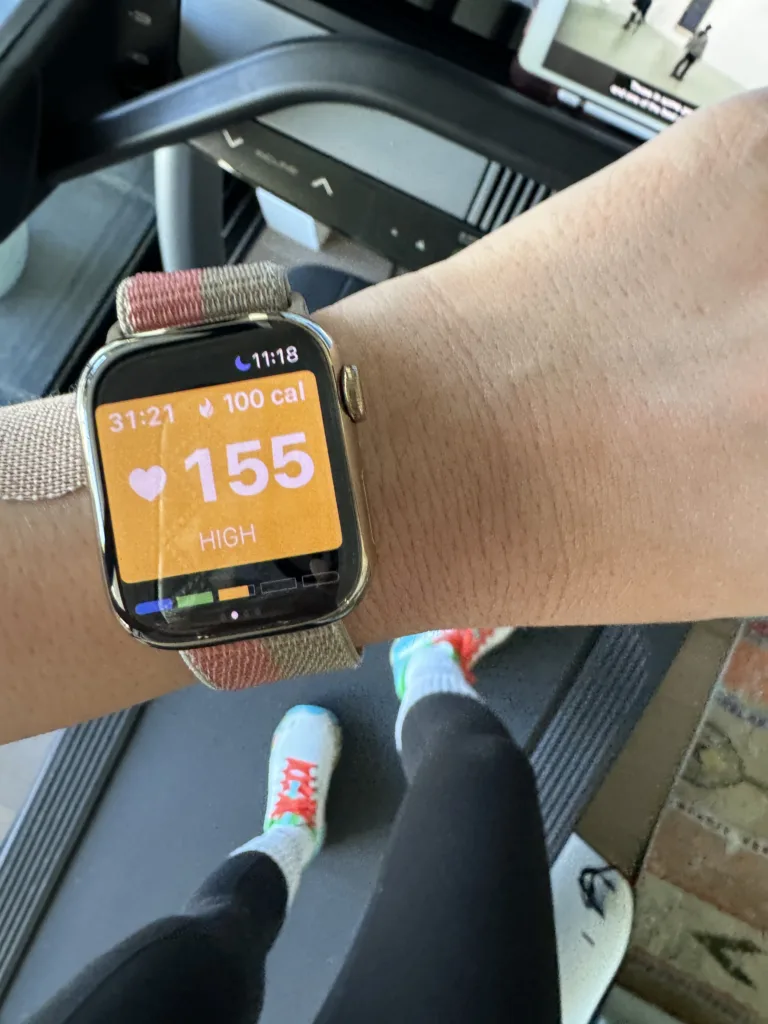
Ever since I’ve been testing out slow cardio like the 12-3-30, I’ve noticed my body is just simply liking it more. I’m better at it. It’s weird because my heart rate gets high (higher than when I’m running) and yet my muscles aren’t dying. Mentally and emotionally, I’m not dying either! To be completely honest, it’s the first cardio I think I’m actually good at and getting better at, which is so exciting!
It all kinda goes back to what your body is better suited for. I have the endurance to push through slow hard things (that’s why I’m good at Pilates) but I know I’m bad at fast sprints (that’s why I never really enjoyed HIIT). It’s just not meant for my body, so I gas out really fast.
Give this a try if fast cardio didn’t work for you either! I’m seeing changes in my body and my booty…and I love!
Oh and if your treadmill doesn’t go to 30, try a step mill!
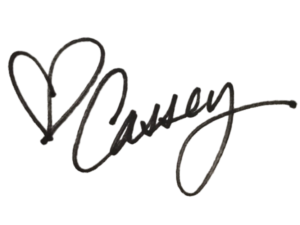
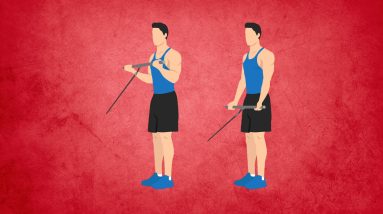
Get Sculpted Biceps with the Double Arm Cable Biceps Curl: Your Ultimate Exercise Guide for Defined Arms
Are you looking for an effective exercise that targets your biceps and helps you build strength? Look no further than the Double Arm Cable Biceps Curl! This exercise is designed to target your biceps and forearms, making it an excellent choice to add to your workout routine. Here at FitGAG, we’ve put together our expert guide to help you master the Double Arm Cable Biceps Curl and reach your fitness goals.
Exercise Information
The Double Arm Cable Biceps Curl is a resistance training exercise that targets the biceps muscles. This exercise involves using a cable machine to add resistance throughout the entire range of motion, increasing muscle activation in the targeted muscle group. Let’s dive into some general information about this exercise:
Level
The Double Arm Cable Biceps Curl is a beginner-level exercise that is suitable for individuals of all fitness levels.
Equipment
To perform the Double Arm Cable Biceps Curl, you will need a cable machine.
Type of Exercise
The Double Arm Cable Biceps Curl is an isolation exercise that targets the biceps muscles, involving a single-joint movement that mainly focuses on one specific muscle group.
Double Arm Cable Biceps Curl: Working Muscles
The Double Arm Cable Biceps Curl is an isolation exercise that primarily targets the muscles of the arms and shoulders. This exercise involves using a cable machine to add resistance to the traditional biceps curl motion. In this section, we will discuss the primary and secondary muscle groups that are involved during the Double Arm Cable Biceps Curl exercise.
Primary Muscle Group: Biceps
The primary muscle group targeted during the Double Arm Cable Biceps Curl exercise is the biceps muscle. This muscle is responsible for flexing the elbow joint and is the primary motion of the Double Arm Cable Biceps Curl exercise.
Secondary Muscle Group: Shoulders
In addition to the primary muscle group, the Double Arm Cable Biceps Curl exercise also engages the muscles of the shoulders. The rotator cuff muscles and middle deltoid muscles are engaged during the curl motion to stabilize the joint and maintain proper posture.
By engaging both the primary and secondary muscle groups, the Double Arm Cable Biceps Curl exercise provides a comprehensive upper body workout. This makes it an effective exercise for building arm and shoulder muscle strength and size, improving posture and stability, and developing functional fitness for activities in daily life.
Stay tuned for the next section, where we will discuss the benefits of the Double Arm Cable Biceps Curl exercise.
Benefits of Double Arm Cable Biceps Curl
Double Arm Cable Biceps Curl is an exercise that targets your biceps muscles and offers several benefits. Here are five benefits of incorporating this exercise into your fitness routine:
- Increased Strength: Double Arm Cable Biceps Curl helps increase overall biceps strength by targeting all of the muscles in the biceps.
- Improved Muscle Endurance: Double Arm Cable Biceps Curl engages more muscles in the biceps, which can help improve overall muscle endurance.
- Improved Upper Body Posture: Double Arm Cable Biceps Curl helps improve your upper body posture by strengthening your biceps muscles and improving your overall upper body alignment.
- Reduced Risk of Injury: Double Arm Cable Biceps Curl can help improve your overall joint stability and reduce the risk of injury and strain on your biceps muscles.
- Variation and Progression: Double Arm Cable Biceps Curl can add variation to your upper body workouts, which can help prevent boredom and stimulate new muscle growth. Additionally, the exercise can be made more challenging by increasing the weight or increasing the number of reps.
By incorporating Double Arm Cable Biceps Curl into your fitness routine, you can enjoy these benefits and more. However, it’s important to start slowly and progress gradually to avoid injury and ensure proper form. Additionally, it’s important to incorporate a variety of exercises into your fitness routine to ensure you’re targeting all muscle groups and avoiding boredom.
Double Arm Cable Biceps Curl: Step-by-Step Instructions
The double arm cable biceps curl is an exercise that targets your biceps muscles. Here are the step-by-step instructions for performing the double arm cable biceps curl:
Starting Position:
- Attach a double-handled cable attachment to a low cable pulley.
- Grab the handles with both hands, palms facing up.
- Stand with your feet shoulder-width apart and your arms extended straight down.
Now, let’s move on to the step-by-step instructions for the double arm cable biceps curl:
- Begin by bending your elbows and curling your hands up towards your shoulders.
- Make sure to keep your upper arms stationary throughout the movement.
- Pause briefly at the top of the movement, when your hands are near your shoulders.
- Slowly release the handles and bring your arms back to the starting position.
Repeat the movement for the desired number of repetitions.
Double Arm Cable Biceps Curl – Proper Form and Technique
The Double Arm Cable Biceps Curl is an effective exercise that targets the biceps muscles. This exercise is performed using a cable machine, and proper form and technique are important to avoid injury and achieve maximum results.
Starting Position
- Stand with your feet shoulder-width apart and the cable machine set to the desired weight.
- Grip the handles of the cable machine with both hands, with your arms extended straight down in front of you.
- Engage your core muscles and maintain a stable base.
Proper Form and Technique
- Curl Up: Curl the handles up towards your shoulders, keeping your elbows close to your sides.
- Keep Your Arms Straight: Keep your arms straight and your elbows slightly bent throughout the exercise, using your biceps muscles to control the movement.
- Return to the Starting Position: Return to the starting position by slowly lowering the handles back down in front of your body.
- Breathe Deeply: Breathe deeply and regularly throughout the exercise to maintain your energy and focus.
- Gradually Increase Intensity: Gradually increase the weight of the cable machine over time as your biceps muscles become stronger.
- Incorporate into Your Routine: The Double Arm Cable Biceps Curl can be a great addition to your upper body training routine, helping you to build strength and muscle effectively.
By following these tips, you can perform the Double Arm Cable Biceps Curl with proper form and technique, building and strengthening your biceps muscles effectively while minimizing the risk of injury. Remember to start slowly, focus on your breathing, and gradually increase the difficulty and intensity of the exercise over time.
Frequency and Progression: How to Get the Most Out of Your Double Arm Cable Biceps Curl Workouts
The Double Arm Cable Biceps Curl is a resistance cable exercise that primarily targets the biceps muscles. In this section, we will discuss how to properly incorporate the Double Arm Cable Biceps Curl into your workout routine and how to progress with this exercise over time.
Frequency
To see significant results with the Double Arm Cable Biceps Curl, it is recommended to perform this exercise 2-3 times a week. However, it is important to listen to your body and avoid overtraining. If you feel any pain or discomfort, stop the exercise immediately. You can also alternate between the Double Arm Cable Biceps Curl and other biceps exercises, such as barbell curls or hammer curls.
Progressive Overload
To progress with the Double Arm Cable Biceps Curl, it is important to gradually increase the difficulty of the exercise over time. Start with a lighter cable resistance and gradually increase the resistance as you become stronger. Another way to progress is to decrease the rest time between sets or increase the number of repetitions. Gradually increase the resistance and reps/sets and avoid adding too much too quickly.
Mix It Up
To prevent boredom and keep your Double Arm Cable Biceps Curl workouts fresh, it is important to mix up your exercise routine. You can perform the Double Arm Cable Biceps Curl with different types of cables or vary the number of reps and sets. You can also incorporate other biceps exercises, such as concentration curls or spider curls.
Proper Form
Proper form is essential when performing the Double Arm Cable Biceps Curl to avoid injury and get the most out of the exercise. Start by standing with both feet shoulder-width apart and the cable handles at chest height. Curl both arms towards your chest, keeping your upper arms still and your elbows close to your body. Squeeze your biceps at the top of the movement, then slowly lower the cable handles back to the starting position. Keep your core engaged and your back straight throughout the movement.
Track Your Progress
To ensure you are making progress and staying on track with your Double Arm Cable Biceps Curl workouts, it is important to track your progress. Keep a workout journal or use a fitness app to log the cable resistance, reps, and sets for each exercise. This will help you identify areas where you need to improve and keep you motivated to continue pushing yourself.
Incorporating the Double Arm Cable Biceps Curl into your biceps workout routine can be a great way to build strength and improve your arm muscles. By following these tips for frequency, progressive overload, and proper form, you can ensure that you are getting the most out of your Double Arm Cable Biceps Curl workouts and reaching your fitness goals.
Mistakes of Double Arm Cable Biceps Curl Exercise
The double arm cable biceps curl exercise is an effective way to target your biceps and improve upper body strength. However, like any exercise, there are common mistakes that can reduce its effectiveness and increase the risk of injury. Here are five mistakes to avoid during the double arm cable biceps curl exercise:
- Not using proper form: Using poor form during the double arm cable biceps curl exercise can reduce its effectiveness and increase the risk of injury. It’s essential to maintain proper alignment of the shoulders, elbows, and wrists throughout the exercise.
- Using too much resistance: Using too much resistance during the double arm cable biceps curl exercise can increase the risk of injury and reduce its effectiveness. Instead, focus on using a cable with appropriate resistance that allows you to maintain proper form.
- Not using a full range of motion: Neglecting to use a full range of motion during the double arm cable biceps curl exercise can reduce its effectiveness. Make sure to fully extend your arms before returning to the starting position.
- Not engaging the biceps muscles: Engaging the biceps muscles is essential to ensure that you are targeting the correct muscles during the double arm cable biceps curl exercise. Failure to engage these muscles can reduce the effectiveness of the exercise.
- Not using proper breathing: Using improper breathing technique during the double arm cable biceps curl exercise can reduce its effectiveness and increase the risk of injury. Make sure to exhale as you curl the cable and inhale as you return to the starting position.
By avoiding these common mistakes, you can ensure that you are getting the most out of your double arm cable biceps curl exercise while reducing the risk of injury. Remember to use proper form, use an appropriate resistance, use a full range of motion, engage the biceps muscles, and use proper breathing throughout the exercise. With consistent practice, you can improve your upper body strength and develop stronger biceps with the double arm cable biceps curl exercise.
Variations of Double Arm Cable Biceps Curl: Add Challenge to Your Upper Body Training
Double Arm Cable Biceps Curl is a great exercise to help target and strengthen your biceps muscles. However, doing the same exercise every day can become monotonous over time. Here are some variations to add challenge and variety to your training routine and challenge your upper body muscles in different ways:
Single-Arm Cable Biceps Curl
This variation involves performing the exercise with one arm at a time, which adds more challenge to your balance and stability and targets your biceps muscles from a different angle. Be sure to keep your core engaged and your knees slightly bent as you perform the exercise.
Cable Biceps Curl with Resistance Bands
This variation involves using heavier resistance bands to add extra resistance and challenge your biceps muscles. Be sure to use proper form and technique and avoid jerking or pulling the bands.
Cable Biceps Curl with Pause
This variation involves pausing for a few seconds at the end of each repetition, which challenges your biceps muscles and improves your overall muscular endurance. Be sure to keep your core engaged and your knees slightly bent throughout the exercise.
Cable Biceps Curl with Isometric Hold
This variation involves holding the fully contracted position of the exercise for a few seconds, which challenges your biceps muscles and improves your overall muscular endurance. Be sure to keep your core engaged and your knees slightly bent throughout the exercise.
Cable Biceps Curl with Overhead Press
This variation involves adding an overhead press to the exercise, which targets your biceps muscles and improves your overall upper body strength and stability.
Incorporating these variations into your Double Arm Cable Biceps Curl routine can help you add challenge and variety to your upper body training and achieve greater gains in overall upper body strength and athletic performance. As always, make sure to use proper form and technique to avoid injury.
Double Arm Cable Biceps Curl: 5 Alternatives to Build Your Biceps
The double arm cable biceps curl is a great exercise for building your biceps and improving your arm strength. However, if you’re looking to mix up your routine or add some variety, there are plenty of alternatives you can try. In this section, we’ll explore five exercises that target your biceps and can help you build strength and improve your arm strength.
Dumbbell Biceps Curls
Dumbbell biceps curls are a great exercise for targeting your biceps and improving your arm strength.
- Hold a dumbbell in each hand and stand with your arms by your sides.
- Curl the weights up towards your chest, keeping your elbows close to your body.
- Lower the weight back down and repeat for the desired number of repetitions.
Hammer Curls
Hammer curls are a great exercise for targeting your biceps and building strength.
- Hold a dumbbell in each hand and stand with your arms by your sides.
- Curl the weights up towards your shoulders, keeping your elbows close to your body.
- Lower the weight back down and repeat for the desired number of repetitions.
Incline Dumbbell Curls
Incline dumbbell curls are a great exercise for targeting your biceps and building strength.
- Sit on an incline bench and hold a dumbbell in each hand.
- Curl the weights up towards your chest, keeping your elbows close to your body.
- Lower the weight back down and repeat for the desired number of repetitions.
Barbell Concentration Curls
Barbell concentration curls are a great exercise for targeting your biceps and improving your arm strength.
- Sit on a bench and hold a barbell with both hands.
- Curl the weight up towards your chest, keeping your elbows close to your body.
- Lower the weight back down and repeat for the desired number of repetitions.
Chin-Ups
Chin-ups are a great exercise for targeting your biceps and improving your arm strength.
- Grab a chin-up bar with an overhand grip and hang from it with your arms fully extended.
- Pull your body up towards the bar, keeping your elbows close to your body.
- Lower your body back down and repeat for the desired number of repetitions.
Incorporating these alternatives to double arm cable biceps curls into your routine is a great way to strengthen your biceps and improve your arm strength. These exercises require little to no equipment and can be done at home or at the gym. Give them a try and see how they work for you!
Double Arm Cable Biceps Curl: Tips and Tricks for Building Bigger Biceps
The Double Arm Cable Biceps Curl is a great exercise for targeting your biceps muscles. In this section, we’ll share some tips and tricks to help you perform the Double Arm Cable Biceps Curl correctly and get the most out of it.
- Warm-Up: Before performing the Double Arm Cable Biceps Curl, it’s important to warm up your entire upper body. You can do this by performing some light cardio or dynamic stretching, such as arm circles.
- Use the Right Equipment: To perform the Double Arm Cable Biceps Curl, you need a cable machine. Make sure you choose the right resistance level for your needs and follow the manufacturer’s instructions for use.
- Proper Form: Maintaining proper form is crucial when performing the Double Arm Cable Biceps Curl. Begin by gripping the cable handles with both hands and standing with your feet shoulder-width apart. Keeping your arms straight, curl the cable handles up towards your chest, then slowly return to the starting position.
- Engage Your Biceps: To perform the Double Arm Cable Biceps Curl correctly, you need to engage your biceps muscles. Focus on squeezing your biceps as you curl the cable handles up.
- Use the Right Repetition Range: Aim to perform 2-3 sets of 8-12 reps with the Double Arm Cable Biceps Curl.
- Mix it Up: Mixing up your Double Arm Cable Biceps Curl routine can help keep your workout fresh and challenging. You can try different variations, such as changing the resistance level or using a different hand position.
- Stretch Afterwards: After performing the Double Arm Cable Biceps Curl, it’s important to stretch your entire upper body, especially your biceps.
- Listen to Your Body: As with any exercise, it’s important to listen to your body and avoid pushing beyond your limits. If you feel any discomfort or pain, stop the exercise immediately.
Incorporating these tips and tricks into your Double Arm Cable Biceps Curl routine can help you get the most out of this exercise and achieve bigger biceps. Remember to always maintain proper form, engage your biceps muscles, and listen to your body. With time and practice, you’ll be able to perform the Double Arm Cable Biceps Curl like a pro and enjoy the benefits of bigger and more toned biceps.
Incorporating Double Arm Cable Biceps Curl into Your Workout Routine for Maximum Effect
Double arm cable biceps curl is a great exercise for strengthening your biceps and building upper body strength. Here are some tips to help you incorporate this exercise into your workout routine for maximum effect:
- Warm-up properly: Before doing double arm cable biceps curl, it’s important to warm up your upper body with exercises like arm circles, push-ups, and shoulder rotations.
- Use proper form: To perform double arm cable biceps curl, stand with your feet shoulder-width apart and hold a cable handle in each hand. Keeping your elbows close to your sides, curl the handles up towards your shoulders. Return to the starting position and repeat.
- Mix up your routine: Don’t just perform double arm cable biceps curl in isolation. Mix it up by incorporating other exercises that target your biceps, such as hammer curls and incline biceps curls.
- Use progressive overload: To continue to see progress, you’ll need to use progressive overload, which means gradually increasing the resistance or repetitions over time.
- Don’t overdo it: It’s important to give your muscles time to recover, so don’t overdo it with double arm cable biceps curl. Aim to perform the exercise for 2-3 sets, 1-2 times per week.
- Focus on your breathing: It’s important to regulate your breathing throughout the exercise to ensure that you’re getting enough oxygen to your muscles. Inhale as you curl the handles up and exhale as you return to the starting position.
- Engage your core: To get the most out of double arm cable biceps curl, make sure to engage your core muscles, including your abs and lower back. This will help you maintain proper form and prevent injury.
- Rest between sets: Allow your muscles time to recover between sets. Rest for 60-90 seconds between sets to ensure that you’re performing each rep with proper form.
- Incorporate double arm cable biceps curl into your workout routine: In addition to incorporating double arm cable biceps curl into your workout routine, consider doing them as part of a superset or a circuit to challenge your muscles even more.
By incorporating these tips into your workout routine, you’ll be well on your way to maximizing the benefits of double arm cable biceps curl and achieving stronger biceps and upper body strength.
Ultimate Workout Plan for Double Arm Cable Biceps Curl
Double Arm Cable Biceps Curl is a great exercise for strengthening your biceps and developing your arm muscles. Here’s a one-week workout plan to help you incorporate Double Arm Cable Biceps Curl into your routine:
Day 1: Warm-up
- Warm-up: 5-10 minutes of cardio
- Double Arm Cable Biceps Curl: 3 sets x 12-15 reps
- Dumbbell Chest Flyes: 3 sets x 10 reps
- Seated Rows: 3 sets x 10 reps
- Tricep Pushdowns: 3 sets x 12 reps
- Cool-down: 5-10 minutes of stretching
Day 2: Rest Day
Day 3: Upper Body
- Warm-up: 5-10 minutes of cardio
- Double Arm Cable Biceps Curl: 3 sets x 12-15 reps
- Lat Pulldowns: 3 sets x 10 reps
- Shoulder Press: 3 sets x 10 reps
- Hammer Curls: 3 sets x 12 reps
- Cool-down: 5-10 minutes of stretching
Day 4: Rest Day
Day 5: Full Body
- Warm-up: 5-10 minutes of cardio
- Double Arm Cable Biceps Curl: 3 sets x 12-15 reps
- Deadlifts: 3 sets x 12..
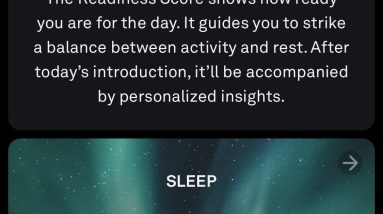
A Complete Day, From Dawn till Dusk: Unveiling the Secrets of Optimal Health and Fitness
This post is sponsored by my friends at NOW Foods. It’s one of my favorite places to shop for pantry essentials, supplements, pet care, and natural beauty. You can use my code FITNESSISTA for 20% sitewide here.
Hi friends! I hope you’re enjoying the morning so far! I’m popping in with an old-school style Day in the Life type post. There were quite a few requests for more posts like this in the annual survey (thank you for your help with this!), so here we go!
Morning
6:45am. My alarm goes off. If I have to take the kids to school, I have to wake up 15 minutes earlier to get dressed, but since the Pilot is doing drop-off, I get an extra 15 minutes. Bless it. I hadn’t worn my Oura ring for a while, so I had to reset it to factory settings, and I was excited to see my sleep and readiness score for the day.

I wake up the kids, head downstairs, and pack up lunches, backpacks, snacks, and sweaters. I make them oatmeal with peanut butter and berries for the road, they head off to school, and I get ready for a workout. While I’m getting dressed, I chug a giant green juice, eat a banana, and half a bar.
I also drink some ginger tea:

8:15 A challenging and fun pure barre Define class. This is a newer class option and it’s all strength-based. I love the mix of barre and traditional strength training moves.
9:30 back home and having the rest of my breakfast: two scrambled eggs and a smoothie with avocado, pumpkin seeds, frozen zucchini, cocoa powder, dates, protein powder, and almond milk.

I have my morning supplements (loving this Omega-3, NAC, quercetin + zinc, and elderberry for this time of year), and eat at my computer while answering emails and publish a reel to IG.


10:30 Kristi is here to shoot blog content photos, which explains why some of the photos in this post are professional/gorgeous and others are quick real-life on the fly ? We shoot about once a month and it makes a huge difference to have blog photos ready to go for upcoming posts.

11:30 We finish photos for 5 blog posts (!), and I take Maisey for a walk around the neighborhood.
Afternoon
12:00 Lunch! A salad with tuna, chopped veggies (bell pepper, radish, beets, cucumber), different types of lettuce, quinoa (pre-cooked during meal prep and waiting in the fridge) and a tahini vinaigrette. I’ve been trying to take a *real* lunch break lately (instead of only eating at the computer), so I’ll eat outside, listen to a podcast or watch an episode of Friends. I sit at the dining room table and listen to an audiobook while I eat for 15 minutes.

12:15-2:30 Work blitz. I write two blog posts and edit an upcoming podcast episode, while sipping on green tea and I snack on some chocolate. I start the podcast episode for post-production uploading (to remove any excess sounds and stabilize the volume) and take a pause on work stuff while it’s back to mom mode. Before I leave for pickup, I do 7 minutes on the PEMF mat with a short meditation.
3:00 The kids are out of school. We head home, start homework, I make them a snack plate, and get Liv ready for dance.
Evening
5:15 After dropping Liv at dance, P and I finish her homework while I prep dinner: chopped chicken salad. This is one of my favorite ones to make it advance so it’s ready to go for the evening! I use rotisserie chicken, steamed edamame, rice noodles, and I’ll add coleslaw mix, chopped green onions, bell peppers, cilantro, peanuts, and make a peanut dressing with Tamari, peanut butter, rice vinegar, honey, sriracha, ginger, garlic, sesame oil, and olive oil. I cover the salad and put it in the fridge, and keep the dressing separate in a jar until it’s ready to use.
6:15 P and I take a short bike ride/walk around the neighborhood and the Pilot comes to home to high-five me and take over. I pack up some salad to take with me in the car. It’s not ideal, but it’s better than waiting until 8:30 to eat.. and thankfully it’s only one night each week.

7pm Choir practice! I look forward to this all week. We’re currently doing Verdi’s Requiem (it’s a LOT, but breathtakingly amazing) and it sets my soul free.

8:30pm I’m back at home. The Pilot has cleaned up the kitchen after dinner, and I make the kids’ lunches and snacks, set out their clothes for the next day, and do a quick cleaning blitz before bed (laundry and wipe down counters). While I’m doing this, P is getting ready for bed, and the Pilot and Liv are doing homework together.
9pm I read a book with P and hang out with her until she falls asleep, while the Pilot finishes homework with Liv downstairs.
After P is asleep, I finish cleaning up for the day, upload my podcast episode and schedule my blog post, and get ready for bed while Liv gets ready for bed.
10:15 I read for a little while, do my evening eye mask, and take magnesium before crashing out!
10:40 Lights out and ready to do it all over again ?
What I liked about this particular day:
I loved all of the different colored veggies I had this particular day! I feel like it was produce-heavy, and I felt energized and satisfied all day. I also loved that I was able to get in a couple of short walks in between work to shake out my legs and get fresh air. Also, it included chocolate and choir, which are two things that make me happy. I hit my protein goal with the protein powder, tuna, chicken, and edamame. Even though it was a busy day and I could have stayed up later reading or unwinding, I’m glad I stuck to my bedtime routine so I’d be rested for the next day.
What I would do differently:
I would say I’d make it less of a scramble, but that’s just where we are right now. I just try to look for moments of peace and stillness where I can take it, and even though the nightly eye mask is a pain, it forces me to take at least 10 minutes to stop and breathe. ?
So, tell me, friends: what’s something that you make time to do each day? Any strategies that help you during this busy season?
xo
Gina
Thank you so much to NOW Foods for sponsoring this post. I’m so thrilled to continue to partner with them, and have been a huge fan of their products for years. You can check out their product line here and use FITNESSISTA for 20% off sitewide. We use and love their supplements, pet care, skincare/beauty, pantry staples, and essential oils.
The post A full day, from start to finish appeared first on The Fitnessista.

Discover the Ultimate Selection of 11 Wholesome Foods to Fuel Your Road Trips
Traveling by road can be exciting, fun, and easy. Whether you are in a car, a bus, or a van, you can get the full amazing experience that comes with traveling by road. When planning for a road trip, there are many important things to put in place. For example, if you own a car, you need to make sure your car is in proper condition. You also need to pack essential luggage, documents, and maps. However, planning what you will eat on the road is very crucial. If you’re on a diet or want to eat healthily, you need to ensure that you plan your road trip food and snacks.
Consuming the right meals while traveling by road is important.
Listed below are various healthy foods for road trips:
11 Healthy Foods For Road Trips

These are some of the most nutrient-dense foods and snacks that you can take on a road trip.
1. Fresh fruit and nut butter
Fresh fruits and nuts are naturally nutritious and portable. They aid in bowel movement and prevent constipation. Apples, strawberries, bananas, and almonds, are examples.
Fresh fruits and nut butter are high in protein and can be used to replace unhealthy snacks when traveling.
2. Unsweetened yogurt
Flavored yogurt has a lot of sugar, which is bad for the human body. Unsweetened yogurt, on the other hand, is good for you since it contains protein. It must, however, be kept cool to avoid spoilage.
3. Roasted chickpeas
Chickpeas are high in protein, fiber, magnesium, and zinc, making them extremely nutritious. Chickpeas might be difficult to package for a road trip, but they can be ordered online to reduce the pressure.
4. Avocados
Avocados are rich in fiber, fat, potassium, vitamin C, E, and folate, all of which are beneficial to health. While traveling, they can be salted and eaten with a spoon or mashed and served with bread or crackers.
5. Cheese and crackers
Cheese and crackers are a classic ready-to-eat snack that can help you fill up on the go. It’s a convenient snack for any traveler. It tastes well with fresh fruits and juice.
6. Dark chocolate and almonds
When you’re on the road and you’re seeking something sweet, stay away from baked foods and sugary beverages. Dark chocolate and almonds are a better choices. Both are potent polyphenol antioxidants that help to protect the heart.
7. Popcorn
Popcorn is a good source of fiber, which might help you stay energized while traveling. However, instead of microwave popcorn, go for fresh popcorn cooked with natural ingredients like corn, salt, and oil.
8. Hard-boiled eggs
This pair of eggs are high in protein, which your body requires for road journeys. Although hard eggs are difficult to prepare, they are simple to store and eat when traveling.
9. Carrots and Grapes
These fruits are high in nutritional value for a healthy body and make a great road trip snack. This is because chewing them minimizes boredom and the risk of eating unhealthy snacks while traveling.
10. Walnuts
Another amazing nut for road trips is walnuts. It contains the most plant-based omega 3 fatty acids required by the body. When you’re on the road, walnuts can help you feel satisfied and less hungry.
11. Coconut chips
This is yet another excellent option for road trips. When properly baked, coconut chips are sweet and crispy. Coconut chips are available in a range of tastes, so you can choose your favorite.
Bottom Line
While on the road, eating healthy meals is a great way to maintain a smooth and stress-free trip. Packing these healthy foods for road trips will ensure you consume nutritiously while on the road.
The post 11 Healthy Foods for Road Trips first appeared on You Must Get Healthy.
The post 11 Healthy Foods for Road Trips appeared first on You Must Get Healthy.

12 Effective Ways for Older Adults Struggling with Obesity to Kickstart Their Fitness Journey
Beginning an exercise routine when you are obese can be challenging, but that shouldn’t deter you from getting started!
No matter what your age, it’s important to approach your goals with patience, consistency, and a focus on your overall well-being.
Here are 12 steps to help you start exercising if you’re an older adult dealing with obesity.
1. Talk to Your Doctor  Photo Credit: Depositphotos
Photo Credit: Depositphotos
Before beginning any exercise program, consult your doctor or a healthcare professional, especially if you have any underlying health conditions or concerns. They can provide guidance tailored to your specific needs and limitations.
2. Start Slow 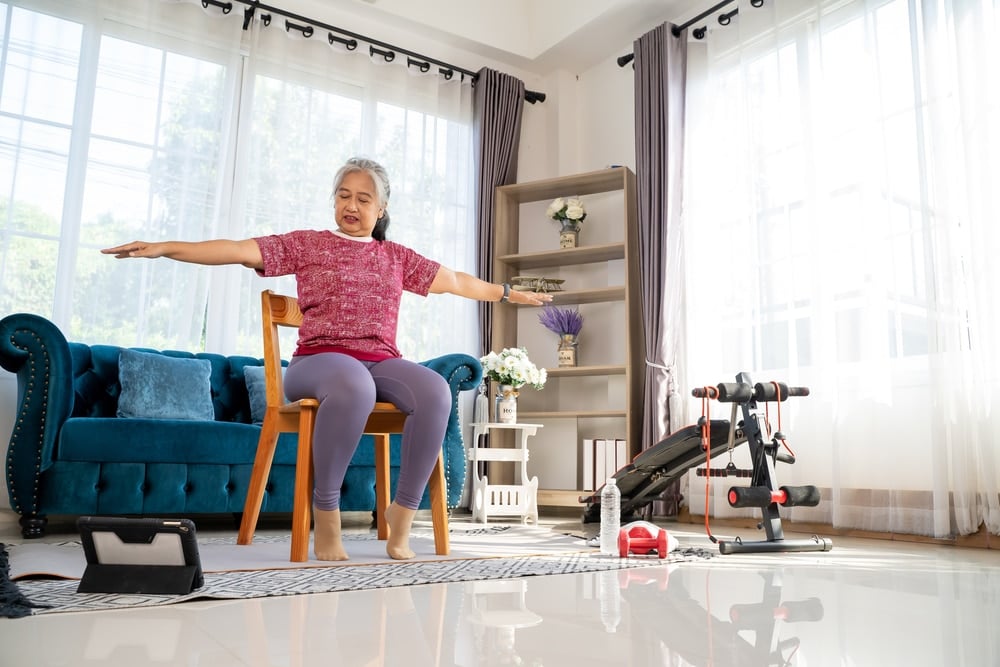 Photo Credit: Shutterstock
Photo Credit: Shutterstock
This is the MOST important! Don’t overdo it on day one. You will likely become discouraged, sore, and possibly even injured.
Begin with low-impact exercises that are gentle on your joints, such as walking, swimming, or cycling. Start with short durations, even as little as 10 minutes a day, and gradually increase the time as your endurance improves.
3. Set Realistic Goals 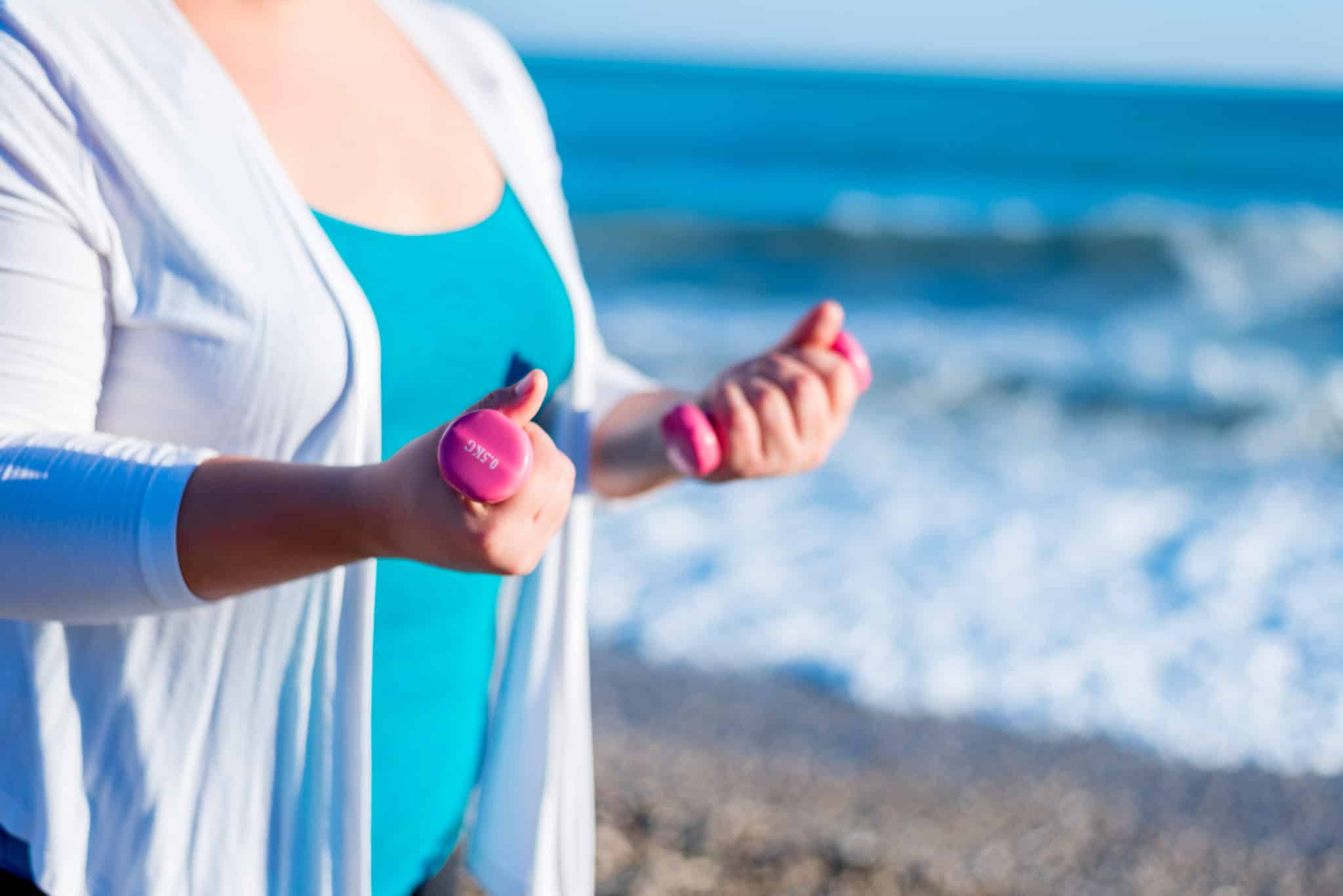 Photo Credit: Shutterstock
Photo Credit: Shutterstock
Set achievable, realistic, and specific goals. Set goals about consistent movement, not just weight loss!
Instead of aiming for significant weight loss at the start, focus on creating healthy exercise habits. Goals like walking for 10-15 minutes a day or reducing sedentary time can be a good start. Keep track of your daily activity and progress.
4. Find Activities You Enjoy  Photo Credit: Shutterstock
Photo Credit: Shutterstock
Look for activities you enjoy doing. Whether dancing, walking, biking, or playing a sport, finding something you like increases the likelihood of sticking with it in the long run!
If you hate the exercise you choose, you won’t stick with it. There is no one right form of exercise; you need to think about what YOU like.
5. Consider Support 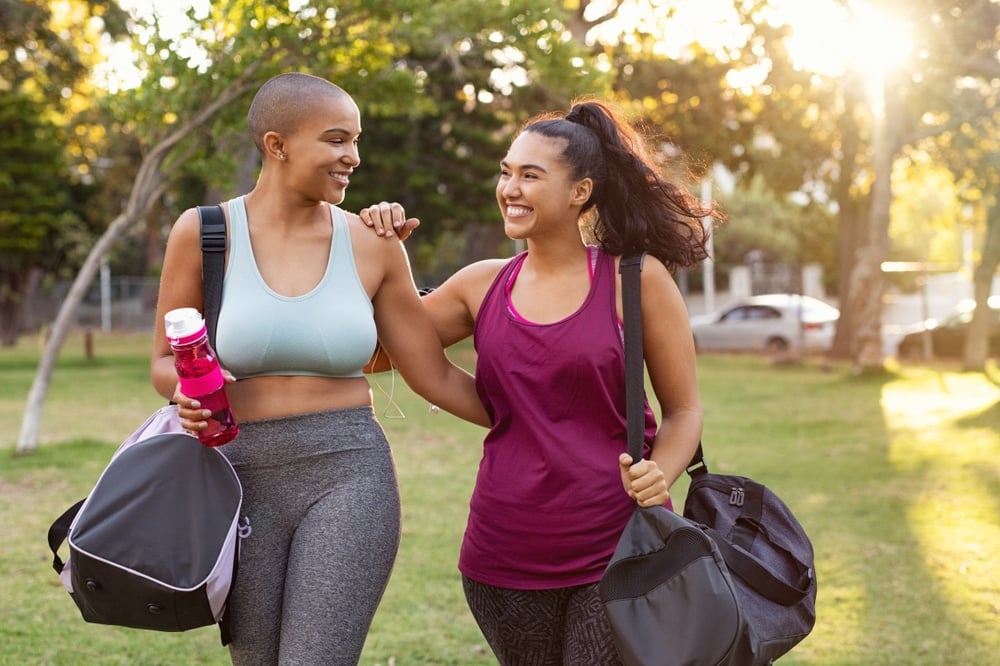 Photo Credit: Shutterstock
Photo Credit: Shutterstock
Exercise with a friend or family member, or consider joining a support group. Having someone to exercise with can provide motivation and make the experience more enjoyable.
You can also find an accountability partner — someone who will check in with you daily to give you encouragement and support.
6. Modify Your Diet  Photo Credit: Shutterstock
Photo Credit: Shutterstock
While exercise is important, weight loss is also significantly influenced by diet. (You can’t out-train a bad diet!)
No matter how you slice it, it’s calories in vs. calories out. Of course, the type of calories matters, so start eliminating processed foods and try to eat real foods like fruits and veggies.
Don’t change everything at once, but be mindful and focused. You can also consult a nutritionist or dietitian to create a balanced meal plan that supports your exercise routine and overall health goals.
7. Focus on Strength Training 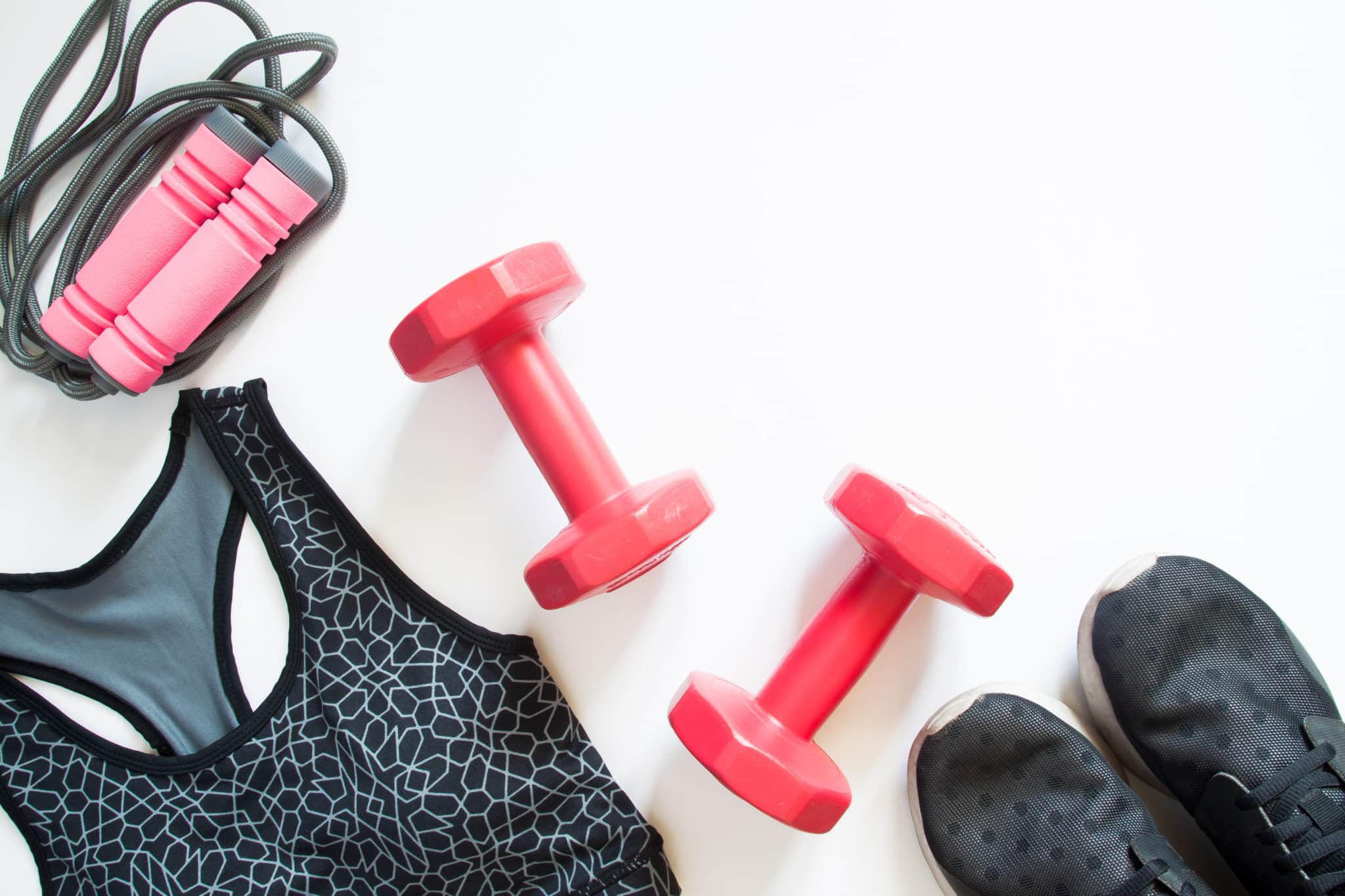 Photo Credit: Shutterstock
Photo Credit: Shutterstock
Incorporate strength training exercises into your routine. Building muscle mass can boost your metabolism and help with weight loss. Start with bodyweight exercises and gradually introduce light weights.
8. Be Mindful of Your Body  Photo Credit: Shutterstock
Photo Credit: Shutterstock
Listen to your body. If you experience pain (not to be confused with the usual discomfort of exercise), it’s a sign to stop and rest. Pushing yourself too hard, especially in the beginning, can lead to injuries.
9. Track Your Progress 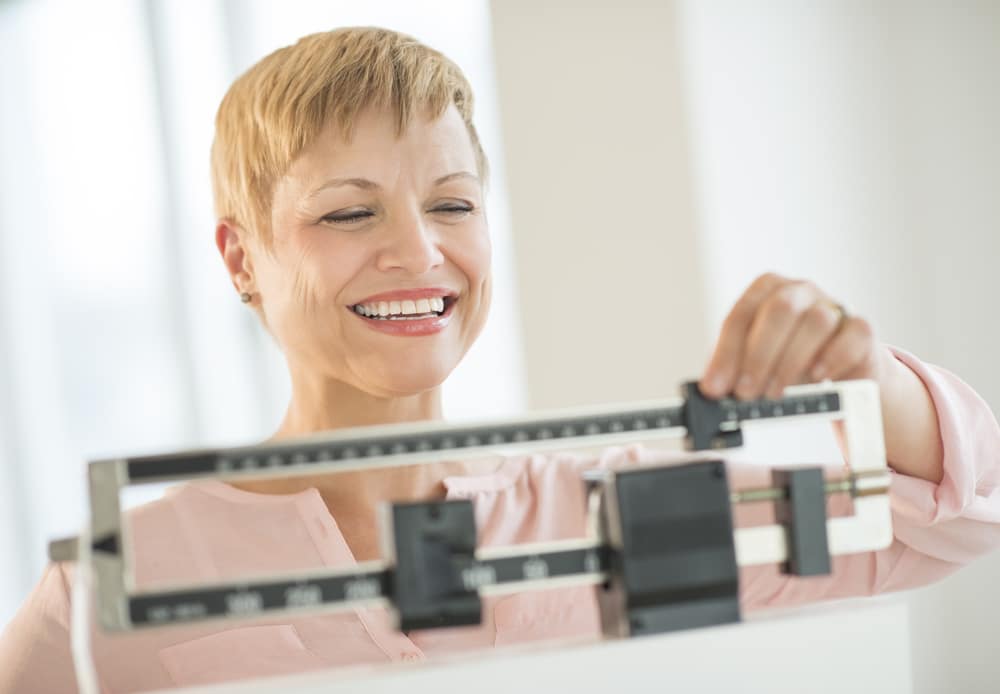 Photo Credit: Shutterstock
Photo Credit: Shutterstock
Keep a record of your workouts. Tracking your progress, whether it’s the number of steps, minutes of activity, or your strength training routine, can be motivating and help you stay on course!
10. Be Patient and Persistent  Photo Credit: Depositphotos
Photo Credit: Depositphotos
Understand that progress may be slow, and setbacks might happen. Stay persistent and be patient with yourself.
Celebrate your achievements, no matter how small they may seem. You didn’t gain the weight overnight, and you won’t lose it overnight, either. You’re in it for the long haul, and you’ll get there!
11. Stay Hydrated and Well-Rested  Photo Credit: Shutterstock
Photo Credit: Shutterstock
Drink plenty of water, especially when exercising. Also, ensure you get enough sleep, as rest is crucial for your body’s recovery and overall well-being.
12. Consider Professional Guidance 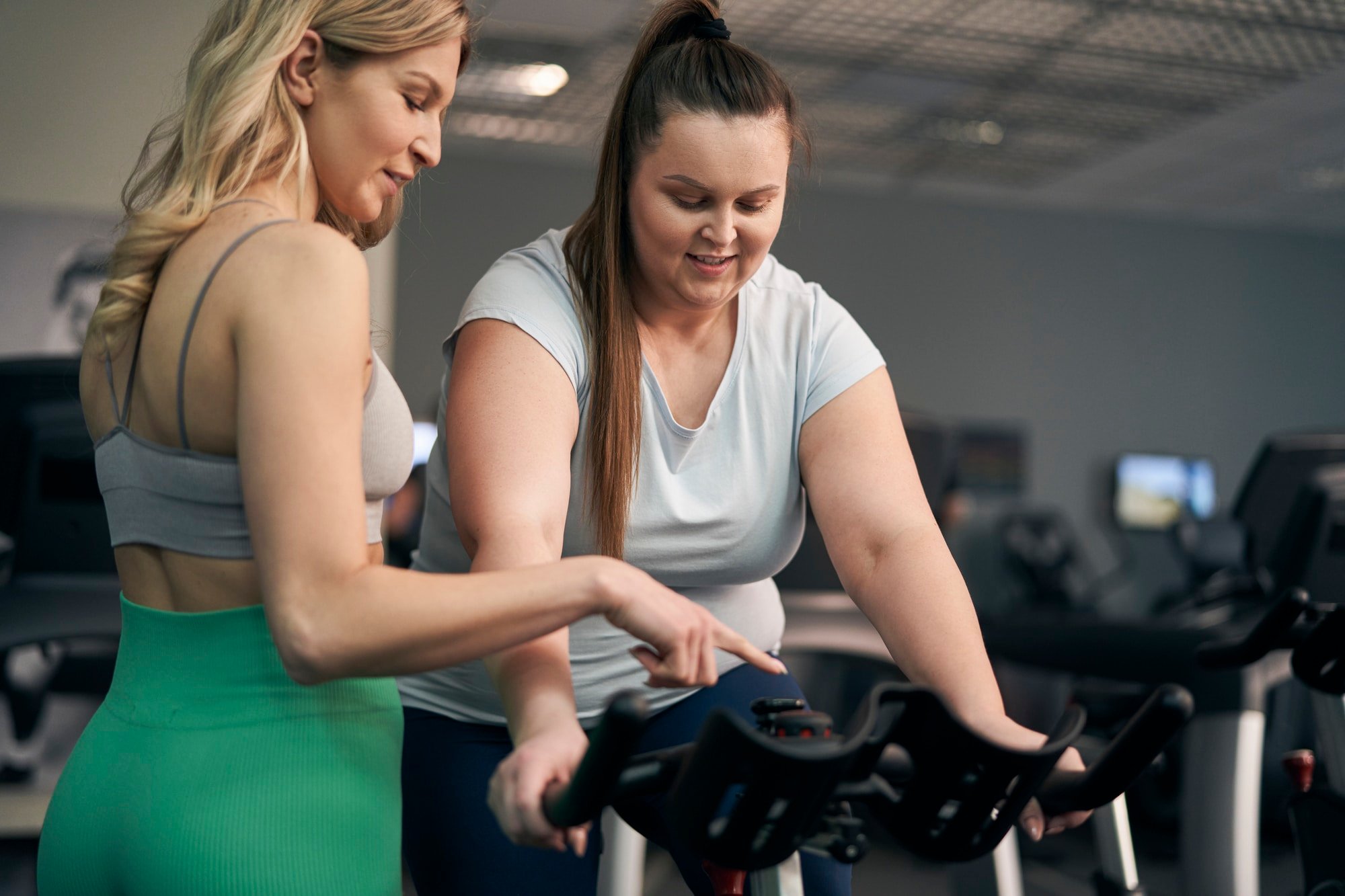 Photo Credit: Depositphotos
Photo Credit: Depositphotos
If possible, work with a certified fitness trainer experienced in working with individuals who are obese. You can also join an online program with beginner exercise programs that are well-instructed.
Remember, the key is to make sustainable changes to your lifestyle. Small, consistent efforts over time can lead to significant improvements in your health and fitness!
Walking For Weight Loss | Your 14-Day Plan 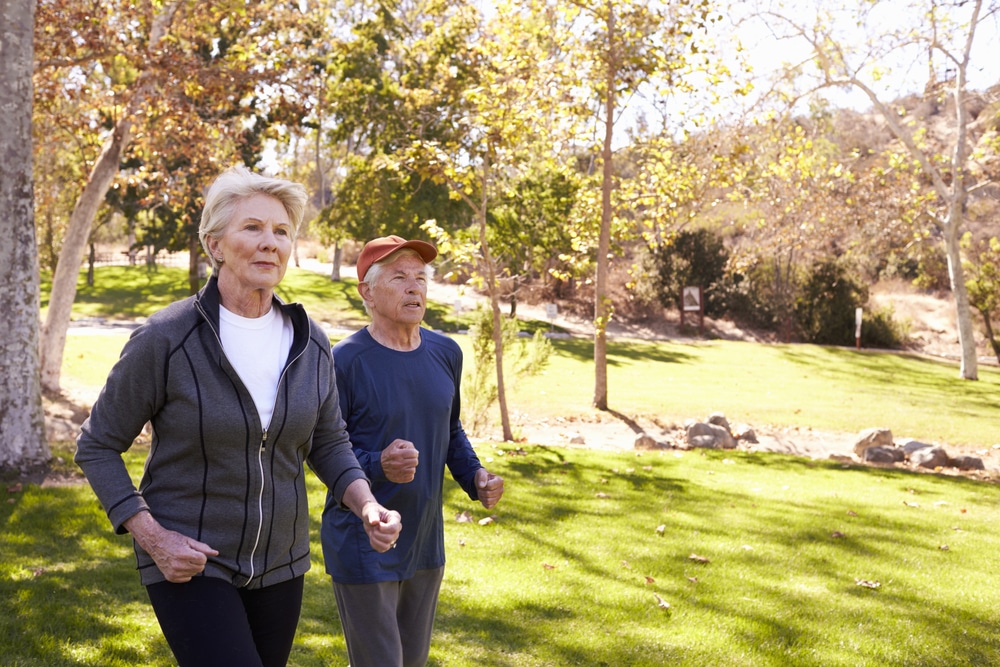 Photo Credit: Shutterstock
Photo Credit: Shutterstock
Guess what—walking works! Study after study proves that people who walk regularly stay more youthful, stronger, and happier in old age. To get started, try my free 14-day challenge and get walking for a weight loss plan.
Whether you like to walk on a machine, around your workplace, or in your neighborhood, walking can and should easily be incorporated into your daily life!
Walking For Weight Loss | Your 14-Day Plan
The Best Core Exercises for Seniors 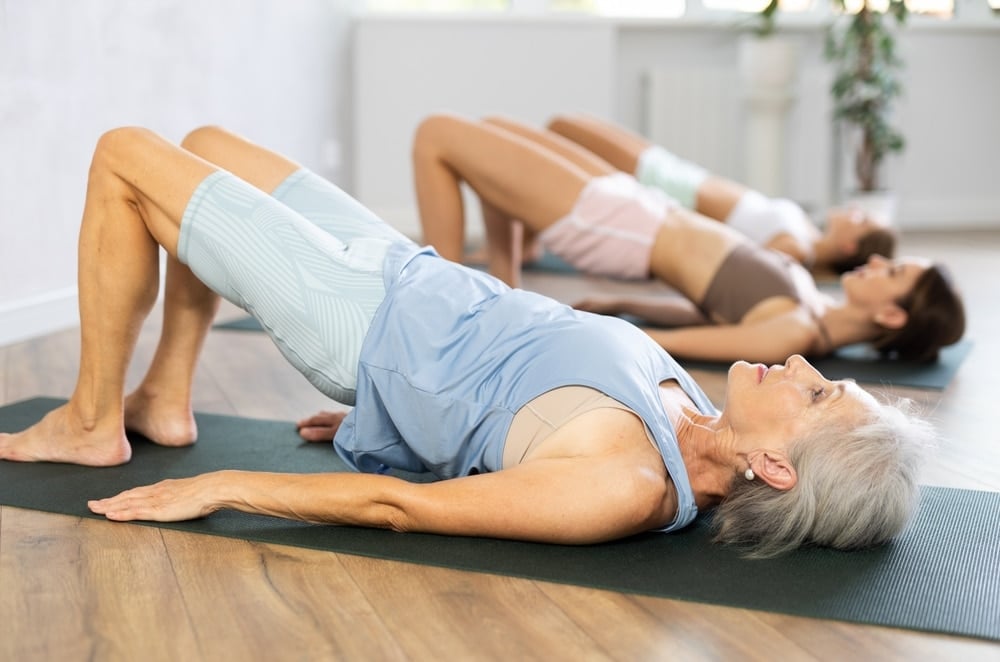 Photo Credit: Shutterstock
Photo Credit: Shutterstock
Ab workouts aren’t limited to athletes and the under-30 crowd!
As a matter of fact, seniors rank as one of the top groups who should be doing core strengthening exercises regularly because targeting your midsection with exercises that sculpt and strengthen is key to staying healthy and active.
The Best Core Exercises for Seniors
Yoga For Beginners | A Complete Guide To Get Started 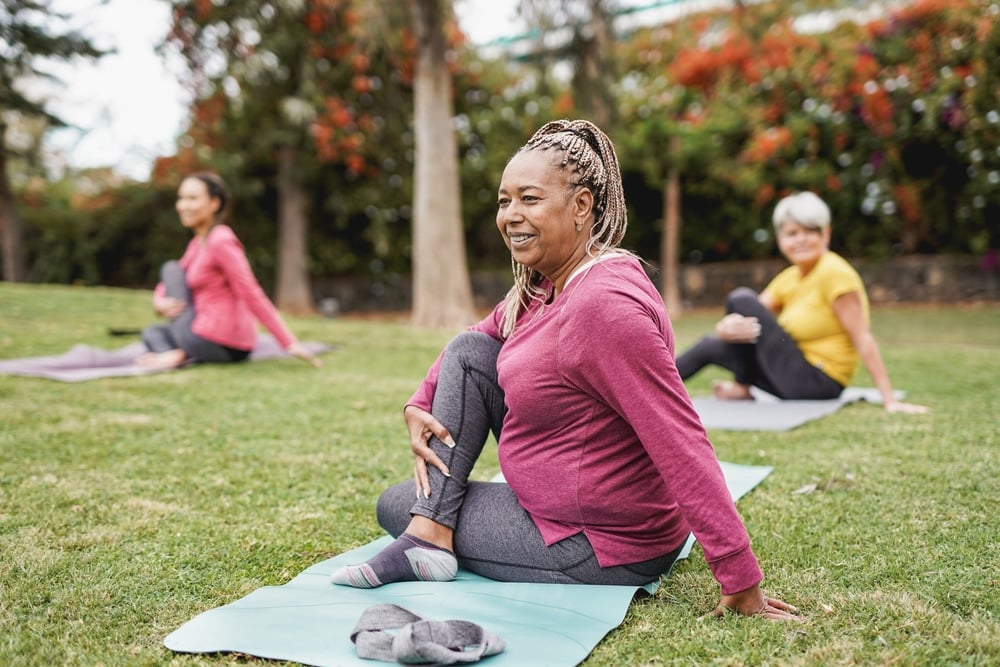 Photo Credit: Shutterstock
Photo Credit: Shutterstock
If you’ve wanted to begin yoga but don’t know where to start, have no fear! This yoga for beginners guide has everything you need to succeed.
Learn the different types and benefits of yoga, as well as guidance on how to get started and choose the practice that works best for you!
Yoga For Beginners | A Complete Guide To Get Started

7 Glute Exercises That Will Give You an Instant Butt Lift
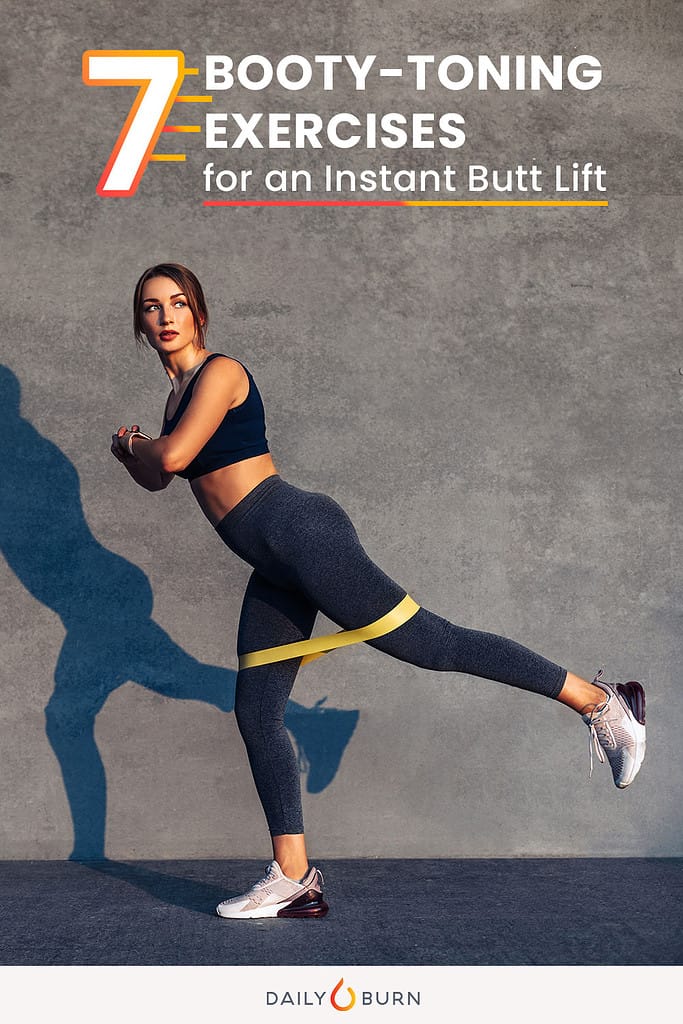
If you’re not a fan of squats, or due to knee issues, don’t feel comfortable dropping low, there’s still hope for your derriere. The revered functional movement is great for building strength, improving mobility and sculpting a curved physique, but it’s not the only exercise that can do the trick.
Single-leg lifts, lateral lunges, and donkey kicks are just a few glute exercises that can help get your booty in gear without getting low. But don’t be fooled, these seven moves, demonstrated by Daily Burn trainers, will still whip your rear into shape. While they don’t require explosive movements like some squat variations, the high reps, pulses and balance moves are guaranteed to make it burn.
RELATED: 5 Better Ways to Sculpt a Stronger Butt
7 Glute Exercises to Tone Your Booty 1. Dirty Dog
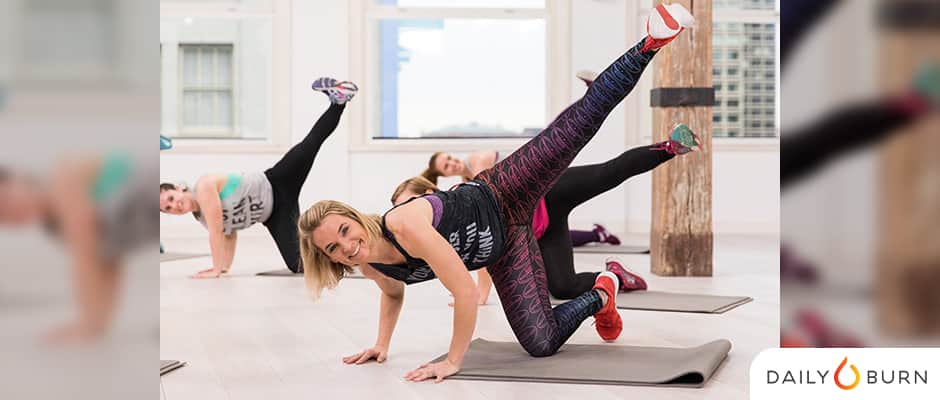
This barre-inspired move, also known as the fire hydrant, will give your glutes, outer thighs, and core some serious sculpting action. Just remember to keep your hips square and lifted to get the most out of this exercise. The bent-knee hip extension will give your core and obliques some TLC, too.
How to: Get into tabletop position with your knees directly under your hips and hands under your shoulders (a). Keeping both knees bent, lift your right leg until your right thigh is parallel to the floor (b). Then, extend your right leg straight, with your right foot flexed (c). Bring the right leg back down to the ground, knee bent (d). Repeat for 10 reps, then switch sides.
2. Donkey Kicks 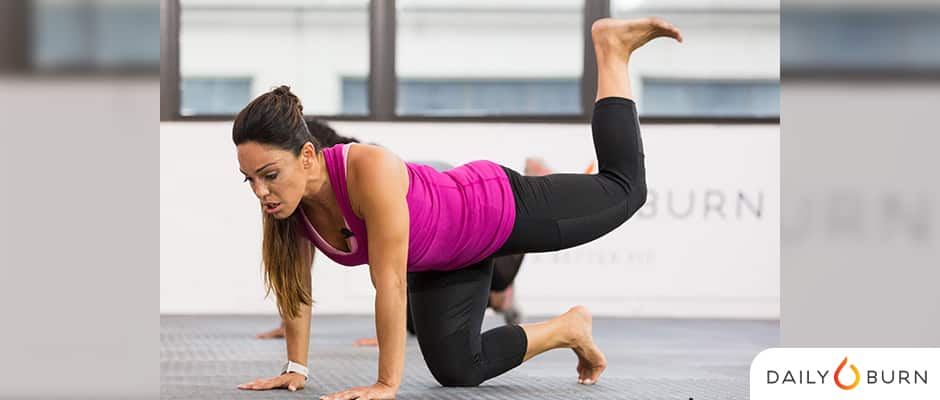
Another highly targeted move, donkey kicks are a great way to fire up the gluteus maximus (the meatiest muscle in your backside, responsible for movement in the hip and thigh). As you kick into gear, make sure to tighten your lower ab muscles and avoid sagging your hips on one side.
How to: Get into tabletop position, keeping your knees directly under your hips, hands under your shoulders and toes tucked (a). Keeping your right knee bent foot flexed and core engaged, press your right foot up towards the ceiling, squeezing your glutes as you reach higher. At the top position, your right thigh and foot should be parallel to the floor (b). Lower your right knee back down to the starting position (c). Do 10 reps, then move on to the left.
RELATED: 5 Glute Bridges You Can Do in Front of Your TV
3. Glute Bridge 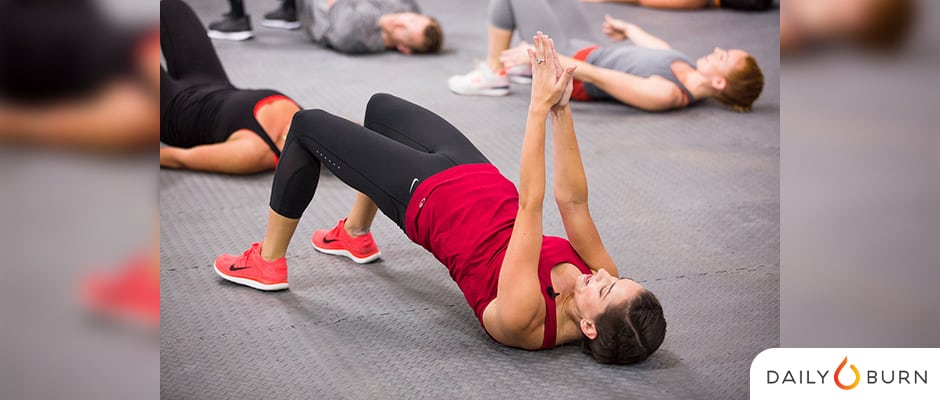
Glute bridges are the perfect booty-shaping exercise because they target all three muscles that make up your butt: gluteus maximus, medius and minimus. They also help stretch your hamstrings and relieve tightness. The key with this exercise is to reach full extension, while keeping your shoulders grounded.
How to: Lay on your back with your knees bent and feet flat on the floor a few inches away from your butt (a). Arms at your sides, or raised out in front of you (palms together), press up into a bridge, lifting your hips and butt off the ground. Keep your shoulders grounded, hips square and body in a straight line from your neck to your knees (b). Hold the bridge for two breaths before you bring your hips and butt back down to the ground (c). Do 10 reps.
4. The Clam 
Mobility masters love this move because it addresses hip rotation and glute strength in one fell swoop. Not only will you work out the kinks from sitting all day, in just a few reps, you’ll start to feel the burn in those glutes and thighs.
How to: Lay on your left side with knees bent, and press up on your left forearm, into a modified side plank (a). Square your hips and place your right hand at your waist. Your body should form a diagonal line from the top of your head to the ground (b). Engaging your abs, glutes and thighs, rotate your top leg open (knee bent), so your legs form a diamond (c). Then, close the clamshell returning to the starting position (d). Repeat for 10 reps per side.
RELATED: 5 Power Lunges for Killer Glutes
5. Lateral Lunge 
Lateral lunges will not only strengthen your glutes but also the muscles around your hip and knee joints. To get the most out of this move, you’ll want to keep your back straight and your chest lifted as you sit back into the lunge. Lateral lunges can also help improve your hip mobility and stretch out tight hamstrings.
How to: Stand with your feet hip-distance apart and hands at your sides (a). Take a big step with your right foot to the right, gently landing with the right knee bent, being careful not to let it extend past your toes (b). Sit your hips back and allow your left leg to straighten, feet planted flat on the ground (c). Reverse the lunge and return to the starting position (d). Do 10 reps per side.
6. Single Leg Touchdowns 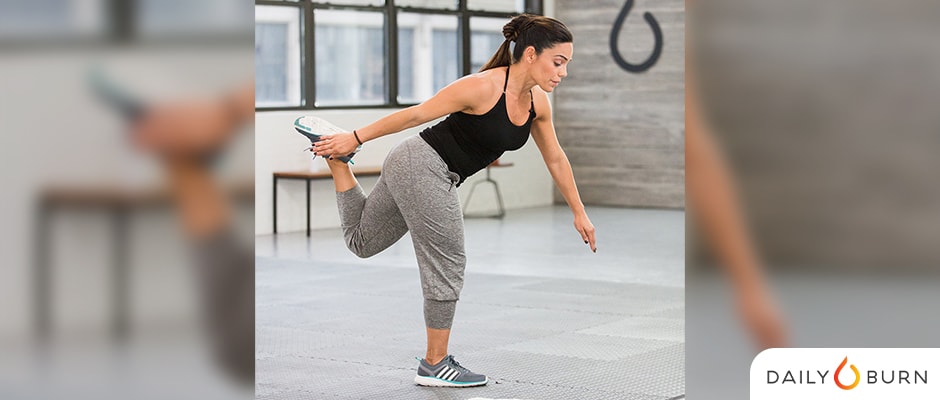
A test of balance and strength, the single-leg touch exercise improves your range of motion and helps loosen your joints. As you stand on one leg, bring awareness to your upper body to help stabilize weight throughout your body.
How to: Stand with feet hip-distance apart with your weight on your left foot, arms at your sides (a). Take your right knee and bend it behind you, and wrap right hand around your right foot. Have a slight bend on your left knee if you need support for balance (b). Engaging your ab muscles and squeezing your glutes, hinge forward at the waist and tap the ground with your left hand (c). Lower your right leg down while lifting your torso back up to the starting position (d). Perform 10 reps on each side.
RELATED: 15-Minute Leg Workout to Tone Up Fast
7. Single-Leg Forward Reach 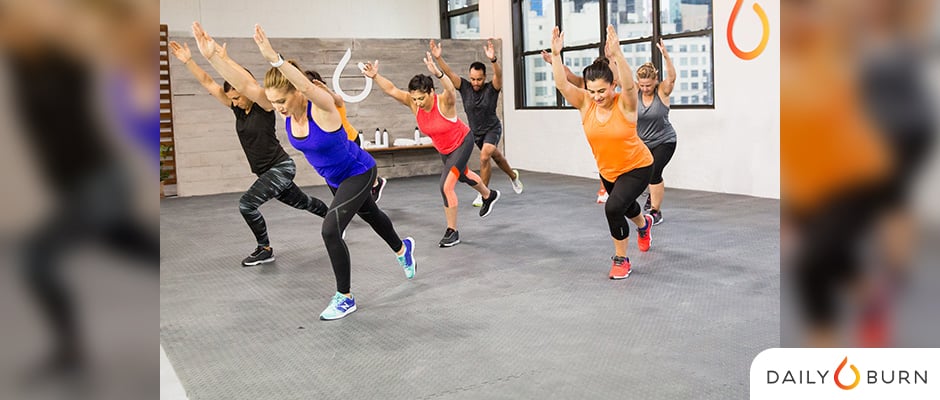
Last but not least, another booty balance challenge. The forward reach will help offset your weight as your leg extends behind you. The name of the game is stability and building a strong base.
How to: Stand with all your weight on your left foot (a). Keeping your left knee slightly bent, extend your right leg straight behind you with your toes hovering just above the floor (b). Then, reach your arms up and hinge forward at the waist as you lift your right leg up until it’s parallel to the floor (c). Pause and hold this position for two breaths (d). Lower your right leg to the floor as you stand upright and rest your right foot on the ground (e). Do 8-10 reps per side.
Not a Daily Burn member? Sign up at dailyburn.com and start your free 30-day trial today.
Feature photos by Ryan Kelly / Daily Burn. Cover image via Shutterstock
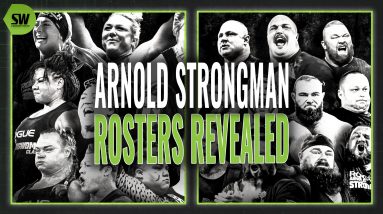
Exploring Arnold Rosters and the Evolution of Bodybuilding: A Journey into Strength and Fitness
Strength Weekly is the show taking you in depth on all aspects of the barbell game and beyond.
This week, we break down the four biggest stories in strength. Rudy Kadlub has a record day, the Arnold Strongman and Strongwoman rosters for 2024 are revealed, and we discuss every era of modern bodybuilding history.
Today, hosts David Thomas Tao and Phil Blechman break down:
00:00 Intro
01:10 Run of Show
02:17 Rudy Kadlub’s MASSIVE Day
05:00 Arnold Strongman Classic Rosters
06:22 Thor’s Big Comeback?
08:40 Arnold Strongwoman Classic Roster
10:10 Bodybuilding through the decades
14:20 Phil’s legendary Arnold impression
16:51 The Modern Era of bodybuilding
Follow David Thomas Tao and Phil Blechman on Instagram.
The post Arnold Rosters PLUS Every Bodybuilding Era — Strength Weekly appeared first on BarBend.
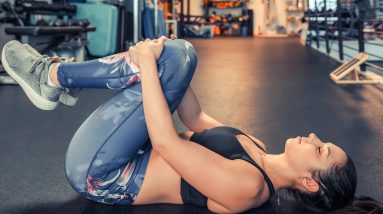
Discover the Fascinating Messages Your Hips are Whispering When They Pop During a Workout
If you’ve ever been in the middle of a workout and noticed that your hips are popping, chances are you’ve been hesitant to power through. Whether you’ve attempted to adjust your movement or skip the offending exercise entirely (leg raises, leg circles, bicycle crunches, and side plank crunches are all common culprits), it doesn’t solve the multi-part mystery of what’s causing it in the first place or how you can keep it from happening in the future.
“No matter what the exercise method is, it’s always the same issue,” Sharyl M. Curry, a certified Pilates instructor and founder of Park East Pilates tells me when I visit her for a session in her New York City studio. “If you’re lifting the leg up and down with your thigh bone jammed up in your hip, that’s when you get the popping,” she explains. This happens when you’re not properly lengthening the leg out of the hip, she says. “You always want to be creating and maintaining space in the joint with the help of the muscles.”
Of course, there are a lot of mechanics going on behind every lift and circle of the leg, and since you won’t be successful in lengthening out of the hip if other alignment issues are in play, Well+Good turned to Curry and NYU Langone physical therapist, Naomi Bailin, DPT for an easy-to-follow understanding of why your hips are popping during a workout.
What exactly is causing my hips to pop?
According to Bailin, there are several possible culprits behind your recurring hip popping, and they’re as simple (and harmless!) as a tendon sliding over a bone to a more serious issue like a labral tear (more on the latter in a bit). But most likely, what you’re experiencing is due to tightness in the connective tissue surrounding the hip joint capsule, which is made up of ligaments that connect bone to bone. “This can result in abnormal mechanics happening in the ball and socket joint in the hip,” Bailin says.
When you’re doing an exercise, such as lying on the floor and raising your legs, Bailin explains that the hip joint should glide downward. “Instead, the joint glides up if that hip is too tight in the connective tissue that encapsulates the joint.” (That’s the “jamming” of the thigh bone Curry mentioned earlier.)
One more thing that’s important to note, both Bailin and Curry say that a weak core is often to blame for this tightness. “We have to stabilize the hip joint so that it can move freely in the socket, and we do that by keeping the torso stable,” says Curry, who adds that by properly engaging the abdominals, you’re then able to create space in the hip joint by lengthening the leg.
On the other hand, a loose body of cartilage or a labral tear can be a more serious issue that causes hip popping, but Bailin notes that it’s more common in professional athletes like gymnasts or dancers (and can often be managed without surgical intervention). “The labrum is the washer that surrounds the socket of the hip joint,” Bailin explains. “It kind of deepens the socket and makes it more stable, and when there’s a tear in there, you can get some deeper clunking and popping.”
Is it really so bad if my hips are popping?
Unless the resulting hip popping is causing you pain, Bailin assures that there’s nothing serious going on. “The popping in and of itself, you don’t have to worry about,” she says. “It’s when it starts to interfere with function—so if accompanied by pain, by limitation, by sensations of instability where the hip is wobbly and making you feel unsteady—that can mean there’s something more going on.”
But even if it’s not causing you pain, hip popping can be an unpleasant sensation, and it is a sign that you’re not using the proper alignment during a workout. That, in turn, leads to relying on different muscles from those that the exercise intends to target, which means you won’t get the full benefits from your workout.
How can I prevent my hips from popping?
How you tackle the issue largely depends on your root cause behind the improper mechanics of the hip. Personally, Curry was quick to diagnose that because I was tucking my pelvis, it wasn’t possible for me to engage my abdominal muscles. That led to the whole domino effect of my hip flexors overcompensating to do the stabilizing work instead, causing the tightness that’s likely behind my hip popping. For general tightness in the hip, Bailin recommends stretching before your workout, suggesting kneeling lunges to target the adductors (inner thighs) and single-leg bridges to target the glutes and core (alternating sides).
If you’re suspicious that a weak core could be to blame, start by taking the time to ensure you’re properly engaging your abdominal muscles. An example, Curry says, is attempting to do leg lifts while lying on your back on the floor while not letting your back arch up off of your mat as you lower your legs. “It’s not the spinal column that has to push down, it’s the muscles that support around the spine,” she explains. “The more you pull in from the front, the more the back will roll onto the mat.”
Bailin adds that if your core isn’t yet strong enough to perform a particular exercise without your hips popping, you can try reducing the range of motion. If you’re getting popping when your legs are going low to the ground, for example, she says not to lower your legs as far down. “[This way] your spine can stay stable, rather than arching back and forth,” she advises. “By doing less, you’re then getting a better workout because you’re using the abdominals for what they’re intended for, which is to avoid spinal motion.”
When should I reach out to a professional?
If your hip popping is ever causing you pain, Bailin stresses that you should book an appointment with a physical therapist to address the issue as soon as possible. “Don’t let problems like this become chronic,” she says. “What can happen is, when you’re moving in a different way because you’re uncomfortable, then another joint can become an issue as a result of the faulty movement patterns. Don’t wait until one thing becomes two, and then two becomes three, and it becomes harder to intervene conservatively.”
For hip popping that’s not causing pain or stability issues, but just won’t seem to go away (and is a major nuisance, like mine), you can still opt to visit a physical therapist. They will be able to assess your alignment and address any issues they find—or direct you to a doctor should you need further medical intervention.

10 Steps to Crafting an Engaging Research Paper on Physical Education
Writing a research paper on physical education can be an enlightening and rewarding experience. This field combines elements of health, physical activity, and education, providing a rich ground for study. Below are the key steps to create a compelling and informative paper.
Choose a Relevant Topic
The first step in writing your research paper is to select an interesting and relevant topic. Physical education encompasses a wide array of subjects, from the impact of sports on mental health to the effectiveness of different teaching methods in PE classes. When choosing your topic, consider current trends in physical education and how they affect various demographics. For instance, you could explore how modern technology is influencing physical education or the importance of physical education in combating childhood obesity. This stage is crucial as it sets the direction for your entire research. For a change, you can order a research paper online and use it as a sample for your writing. Inspect it, notice how it is written and the topic dwells on.
Conduct Thorough Research
Once your topic is defined, it’s time to dive into research. Utilize various sources, such as academic journals, books, reputable websites, and interviews with professionals in the field. This will provide a well-rounded view of your topic. Be sure to focus on recent studies to ensure your information is up-to-date. For example, if you’re writing about technology in physical education, look for the latest advancements and their implications. Your research should be comprehensive, covering all aspects of your chosen topic.
Develop a Clear Thesis Statement
Your thesis statement is the backbone of your research paper. It should clearly state your research’s main argument or primary point. For a paper on physical education, your thesis might focus on the benefits of a specific teaching method or the role of physical education in overall student health. This statement guides your research and writing, ensuring all your points relate to your main argument.
Organize Your Findings
With your research, it’s important to organize your findings logically. A well-structured paper helps in conveying your ideas more effectively. Start with an introduction that sets the context and introduces your thesis. Then, use body paragraphs to present and discuss your research. Each paragraph should focus on a single idea supporting your thesis. For instance, if your paper is about the impact of PE on student wellness, each paragraph could cover different aspects like physical health, mental health, social skills, and academic performance.
Write and Revise
Now, begin writing your paper. Remember to use simple, straightforward language. Avoid jargon and overly technical terms unless necessary. As you write, make sure each section flows smoothly into the next. After completing your first draft, revise it for clarity, coherence, and conciseness. Check for grammatical errors and ensure your arguments are well-supported by evidence. This phase is crucial for refining your paper and making it as strong as possible.
Cite Your Sources
Finally, it’s essential to cite your sources accurately. Proper citation not only gives credit to the original authors but also strengthens the credibility of your paper. You might use APA, MLA, or another citation style, depending on your institution’s guidelines. Ensure that every piece of information borrowed from other sources is properly referenced.
Final Thoughts
You can write a comprehensive and insightful research paper on physical education by following these steps. Remember, a great paper is about presenting facts engaging the reader, and contributing meaningfully to the field. Your paper has the potential to inspire and inform, so take the time to make it impactful.

Save Big on REP Fitness: Unlock Discounts and Earn Rewards in 2023
As a home gym owner and someone who reviews fitness equipment for a living, I’ve become a huge fan of REP Fitness over the years. I have a sandbag, a plyo box, and a weight bench that I love from REP. Many of my colleagues praise the brand’s squat racks, barbells, and weight plates. What’s more, REP’s equipment frequently tops our holiday gift guides for men and women because it’s top-notch without costing an arm and a leg.
We know that most shoppers enjoy a good deal, and using a REP Fitness discount code can help you save even more money. Below, we’ve compiled all the ways you can score special discounts on the equipment you need to build the ultimate home gym.
REP Fitness Discount Codes
Because their products are already reasonably priced, you won’t find too many REP Fitness promo codes. That said, there are ways you can still get the best discount possible on their equipment. Here are all the ways you can save money when shopping on REP Fitness’s website:
- Rewards points: Get points for spending money, leaving reviews, following REP Fitness on social media, or signing up for texts. You also receive points each year on your birthday. For every 100 points you earn, you’ll receive a $5 reward.
- Local pickup discounts: If you live near REP’s showrooms in Moreno Valley, California, or Carlisle, Pennsylvania, and can pick up your items yourself, you may get up to 15% off your order.
- Customer referrals: Refer a friend and offer them $10 off their purchase of $100 or more. Earn $10 in points for every successful referral.
- Free shipping: There’s no need to enter any promotional code for free shipping. As of this writing, REP offers free shipping on all orders made within the lower 48 states.
- Financing: If you prefer to pay for your purchase in smaller installments, choose PayPal or Shop Pay as your payment method at checkout. Financing through Affirm is also available for purchases over $650.
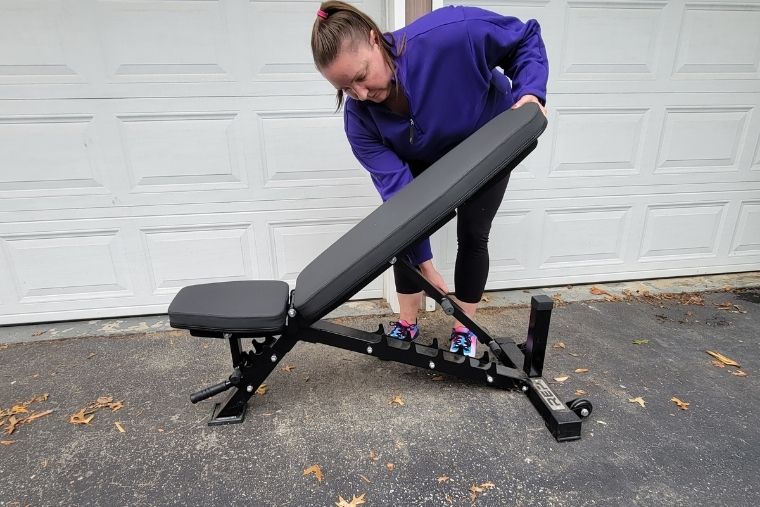 Adjusting the REP AB-3100 Adjustable Weight Bench outside my garageHow to Apply REP Fitness Coupon Codes
Adjusting the REP AB-3100 Adjustable Weight Bench outside my garageHow to Apply REP Fitness Coupon Codes
- Visit repfitness.com.
- Sign up for rewards on REP’s Loyalty Program page with your name and email address. You’ll get points just for creating an account (don’t worry — it’s free) and then earn points for each dollar you spend on the REP Fitness website. Other ways to earn points include following REP’s social media accounts, leaving reviews, and signing up for text alerts. You’ll also receive points on your birthday. One hundred points equals $5 in rewards.
- Redeem your eligible points when completing your order on REP’s checkout page.
- At checkout, selecting PayPal or Shop Pay as your payment method will allow you to pay for your purchase in installments. REP also offers financing through Affirm on orders over $650.
- Save money by picking up your items from one of REP’s showroom locations, if possible. Their showrooms are located in Moreno Valley, California, and Carlisle, Pennsylvania. Discounts start at 10% off purchases up to $2,500 and go up to 15% off purchases of $7,500 or more.

Get REP Fitness Discounts
When Are REP Fitness Products on Sale?
Like most major fitness equipment brands, REP Fitness offers sales around major shopping holidays, such as Cyber Monday. They don’t always offer sitewide sales, but they do usually have daily and weekly deals on select items.
Signing up for REP Fitness’ email newsletter is the best way to get notified when their products go on sale. It’s also an excellent way to get alerts about new products. Alternatively, you can learn about REP Fitness coupons and special discounts by following their social media pages.
For information on fitness equipment deals from all of our favorite brands, keep checking our holiday sales guides below.
- Labor Day Fitness Sales
- Black Friday Fitness Deals
Why We Love REP Fitness
I’ve owned several items from REP for nearly four years, and our Breaking Muscle product testers have tried dozens of REP Fitness barbells, dumbbells, kettlebells, weight benches, functional trainers, and power racks. Almost everything we’ve tested has received high marks for quality, durability, and performance.
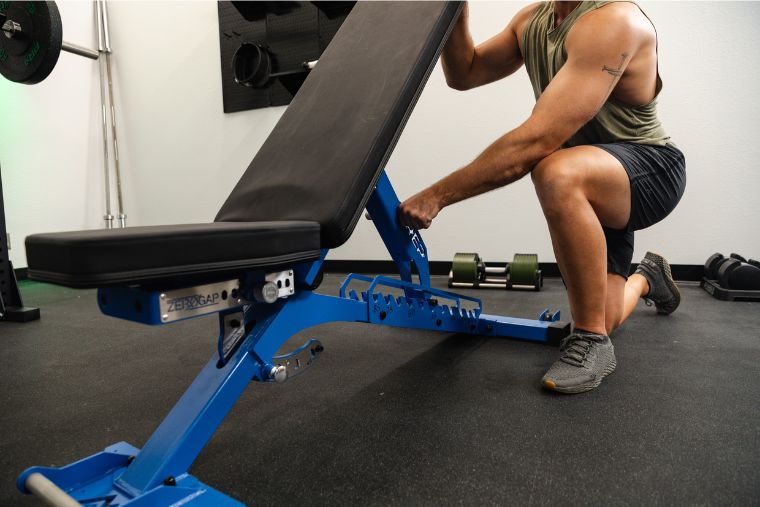 A Breaking Muscle team member adjusting the back of the REP Fitness BlackWing Adjustable Bench
A Breaking Muscle team member adjusting the back of the REP Fitness BlackWing Adjustable Bench
Some of our favorite REP Fitness products are listed below:
- Colorado Bar
- Double Black Diamond Bar
- BlackWing Adjustable Bench
- The FT-5000, which topped our list of the best functional trainers
- The AB-3100 Adjustable Weight Bench, which we consider a high-quality piece of budget-friendly home gym equipment
Why Shop at REP Fitness?
As mentioned, the Breaking Muscle staff is frequently impressed with the quality of REP Fitness’s products, especially considering how reasonably priced much of it is. We also appreciate that REP Fitness offers the following perks:
- A loyalty program with rewards points for completing certain actions on the REP Fitness website or their social media pages
- Free shipping on all orders within the lower 48 United States (as of this writing)
- The ability to finance purchases over $650 through Affirm
- The ability to pay in installments with PayPal or Shop Pay
- Local pickup discounts
- Discounts for successful customer referrals
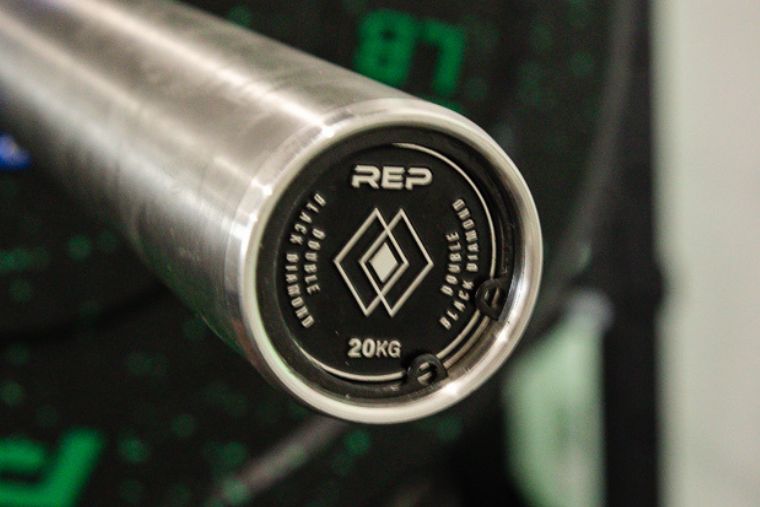 A close-up of the endcap on REP’s Double Black Diamond BarbellFAQs: REP Fitness Discount Code
A close-up of the endcap on REP’s Double Black Diamond BarbellFAQs: REP Fitness Discount Code
In the past, REP Fitness offered first responder discounts and a military discount. As of 2023, they no longer offer these discounts but still give back to the community by supporting three charities: the First Responders Children’s Foundation, Folds of Honor, and the Gary Sinise Foundation.
REP Fitness doesn’t always offer storewide Black Friday sales. Instead, they offer daily or weekly deals on select items throughout the entire month of November.
As of November 2023, REP Fitness offers free shipping on all orders made within the lower 48 states.
The post REP Fitness Discount Code (2023): Ways to Save and Earn Rewards appeared first on Breaking Muscle.

Struggling to Find Motivation for Weight Loss? These 8 Tips Could Be the Game-Changer You Need
If you’re just starting your weight loss journey, it can be tough to stay motivated — and that’s normal!
Losing weight and bettering your health requires serious commitment and lifestyle changes, which isn’t always easy.
To help, we’ve rounded up 8 of the best ways to stay motivated and keep your weight loss on track.
1. Identify Your “Why”  Photo Credit: Shutterstock
Photo Credit: Shutterstock
So, what is the ultimate reason you want to lose weight?
Your “why” is the purpose behind the action that will drive you forward when times get tough. Think of it as your “purpose statement.”
It should be more than just wanting a better physique; it needs to have emotional meaning. It connects to your life values and is so much deeper than just weight loss! (Weight loss is the byproduct of your new habits.)
When it comes to weight loss, one size doesn’t fit all. Every person will have a deeper reason as to why weight loss will change their life.
For example:
- Are you looking to improve your overall health?
- Do you want more energy or confidence?
- Are you trying to stay healthy for your kids or grandchildren?
- Do you have medical issues that would benefit from a healthier weight?
- Are you sick of being tired all the time?
No matter the incentive, figuring out why you’re striving for a transformation can assist in sustaining your dedication and keeping you on track to attaining your ambition. These deeper desires will eventually result in weight loss because you’ll change your habits to achieve them.
Once you’ve identified your why (and it can’t be “weight loss”—you need something meaningful!), it’s time to determine how you will get started by setting your goals.
2. Break Down Larger Goals Into Smaller Steps 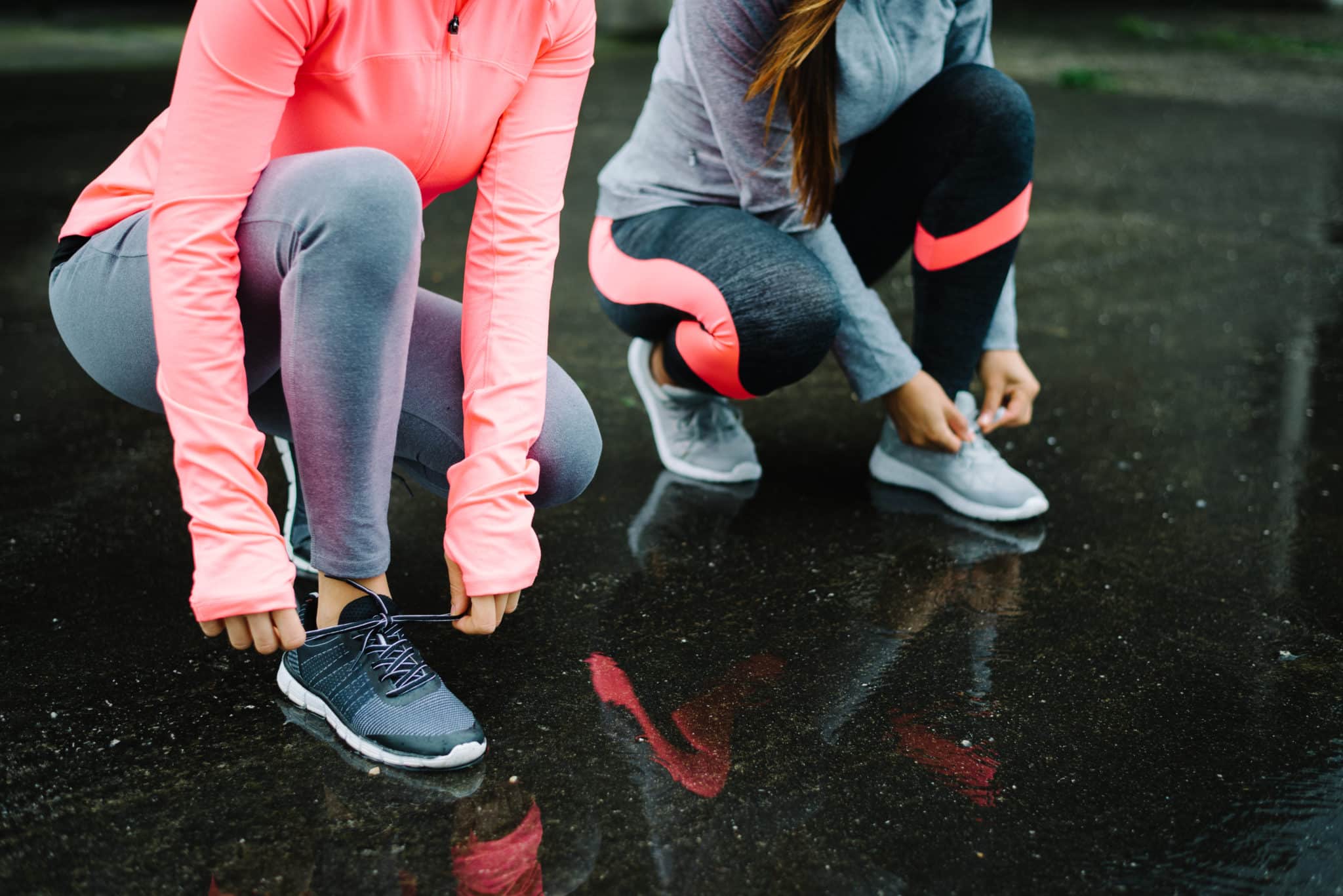 Photo Credit: Shutterstock
Photo Credit: Shutterstock
Achieving success necessitates the need for goals. It helps to focus your energy and create a plan for reaching the desired outcome. Goals should be realistic, measurable, and achievable within a reasonable amount of time.
To ensure that you are setting yourself up for success, it’s best to break down large goals into smaller tasks or steps. Smaller objectives can be established to make the larger goal more manageable and keep you inspired as you progress.
Example: If your aim is to shed 10 pounds by the start of summer, break it down into bite-sized portions, such as losing 1-2 lbs per week for the upcoming months.
Set Weekly or Monthy Mini-Goals, Too
All of your small successes will add up over time and help keep you on track toward achieving your overall goal.
Example: Exercise five times a week for 20 minutes or cut out sugary snacks from your diet completely.
3. Find Your Support System 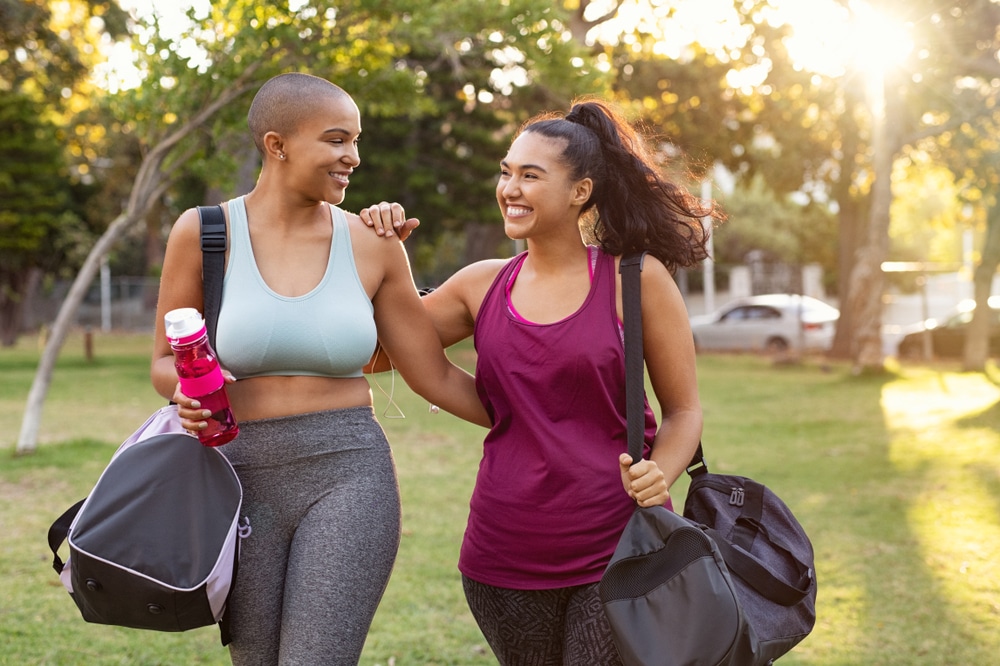 Photo Credit: Shutterstock
Photo Credit: Shutterstock
When aiming to reach objectives, consider who or what support systems you can utilize to ensure success.
Examples:
- Consider asking for support from friends and family who can offer encouragement when needed.
- Join a gym with knowledgeable trainers who can provide guidance during workouts.
- Connect with an online community where people share their experiences related to similar objectives so that you don’t feel isolated on your journey toward success.
4. Create a “Stop/Start Doing” List  Photo Credit: Shutterstock
Photo Credit: Shutterstock
Once your goals are set and organized, it’s time to create a plan of action. This is often where people stop. They set their goals but never really decide how they will actually make them happen.
Creating a solid action plan is essential to achieving any goal. Think of this as the roadmap that will help you get from where you are now to where you want to be.
An action plan will lay out the daily, weekly, and even monthly tasks you need to do. It also involves a timeline for completing each step.
The first step is to create a stop/start doing list. This helps identify the habits you know you need to stop doing and creates awareness of the habits you’d like to adopt.
Example: Let’s say your goal is to eat healthier. Here is your “stop/start doing” list:
- During week one, eliminate added sugars from your diet. (I.e., something to stop doing.)
- During week two, make sure you’re getting five fruits and vegetables per day. (I.e., something to start doing.)
- During the following weeks, add more things to stop and start doing. You’ll create better habits as you do!
5. Create Timelines That Help Fit in New Routines 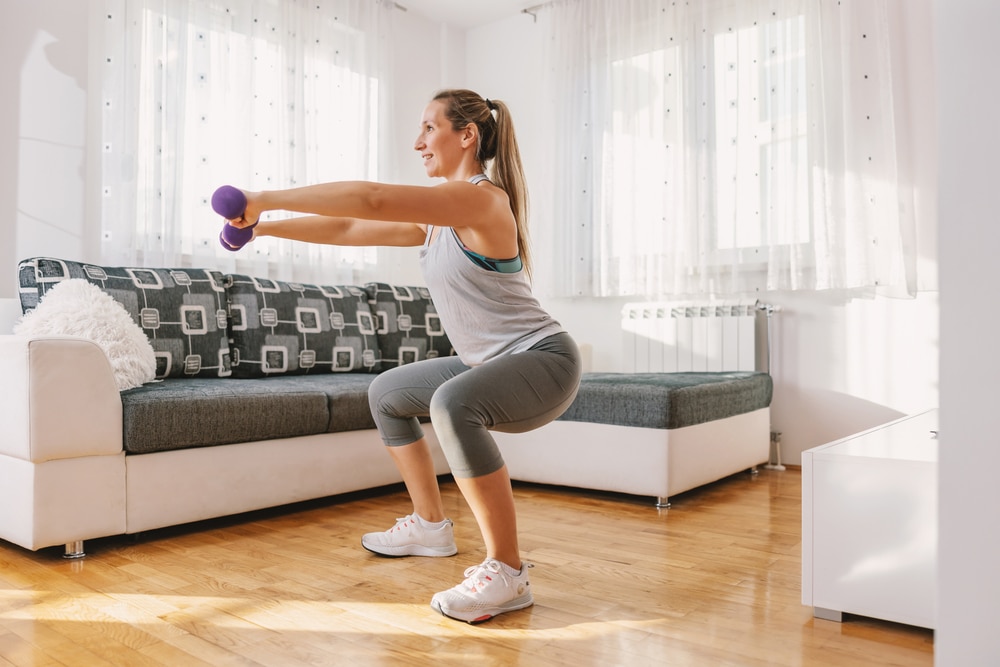 Photo Credit: Shutterstock
Photo Credit: Shutterstock
Consider how much time and effort each new habit will take to fit into your lifestyle without becoming overwhelming or too difficult to manage.
Example: If your nearest gym is 30 minutes away, maybe exercising at home is a better choice. If necessary, adjust the timeline accordingly to work along with your schedule and other commitments.
6. Build In Rewards  Photo Credit: Shutterstock
Photo Credit: Shutterstock
Make sure you add in rewards along the way! This could be in the form of self-care after reaching certain milestones or celebrating small victories with the purchase of something you’ve wanted for a while.
You decide what works for you, but make sure you celebrate the milestones because you deserve it!
7. Monitor Your Progress 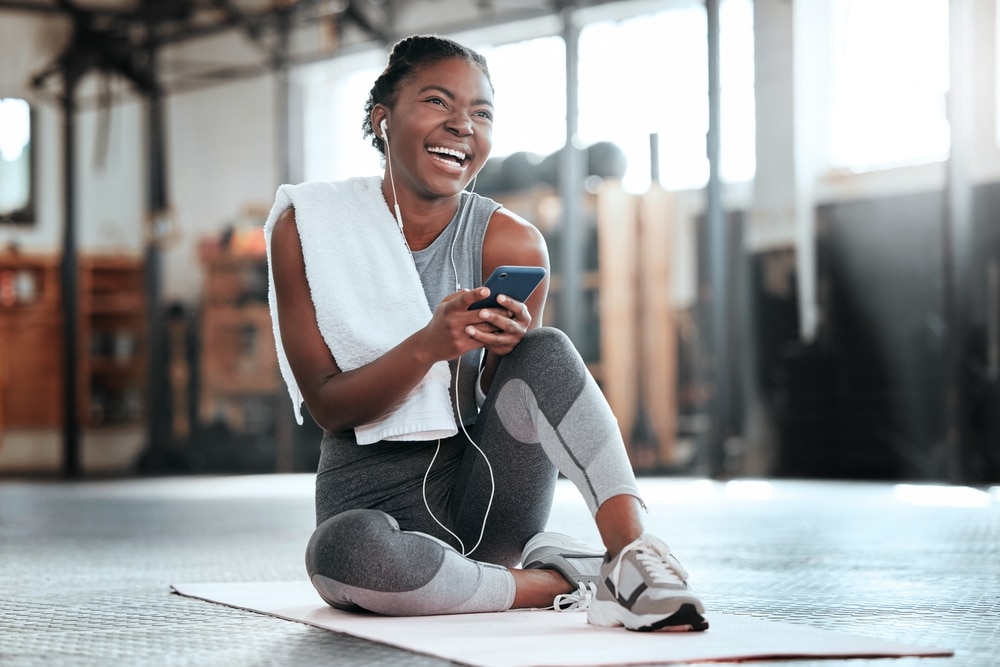 Photo Credit: Shutterstock
Photo Credit: Shutterstock
Regularly monitor progress on each task with weekly reviews. This holds yourself accountable and keeps you motivated!
Remember that you might not reach your goals in the first weeks or months—but don’t get discouraged. Just ensure your action steps are realistic and achievable so they don’t become overwhelming or discouraging.
8. Journal Your “Why”  Photo Credit: Shutterstock
Photo Credit: Shutterstock
Journaling your “why” is a powerful tool to help you stay focused and motivated on the path toward creating a healthier, happier life.
Writing down how you feel before beginning any kind of lifestyle change helps you stay connected with yourself during moments of doubt or discouragement. It allows you time to reflect on your progress thus far and what lies ahead if you remain committed over time.
Journaling before, during, and after your progress allows you access to your innermost thoughts, which gives clarity during the journey.
Expert Tip: As progress is made toward each goal, reviewing your notes and thoughts is insightful! It provides motivation to keep going and allows you to look back over your journey and appreciate how far you’ve come since setting out on your path toward self-improvement.
Weight Loss Motivation Checklist 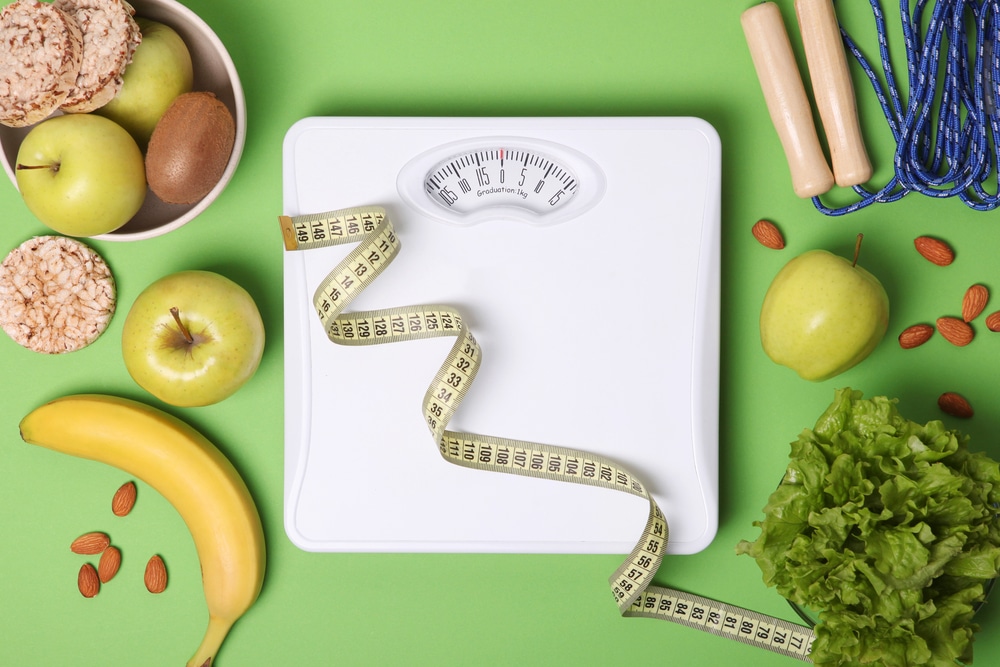 Photo Credit: Shutterstock
Photo Credit: Shutterstock
Staying motivated can be a challenge when progress seems slow or difficult. At the end of the day, weight loss is hard! You need to dig deep inside, find your grit, be patient, and stay the course.
Here’s Your Checklist for Staying Motivated While Losing Weight
A quick recap for reaching your goals:
1. Celebrate small wins: Celebrating small wins along the way can help keep you focused and motivated on your larger goal. Acknowledge each step forward as an accomplishment and reward yourself with something special, like a massage or a night out with friends.
2. Visualize your goals: Take time to visualize what achieving your goals would look like in detail. Connect to how you feel as you get closer. This will help remind you why you are working on these new habits and motivate you to keep going even when things get tough.
3. Find inspiration: Surround yourself with positive people who have achieved their goals or are currently working towards them. Reading stories of success from others can also provide great inspiration and motivation for your own journey ahead.
4. Break down goals into manageable steps: Breaking down large goals into smaller steps makes them more manageable and less intimidating, which helps maintain motivation levels over time. Make sure the steps are realistic and don’t become overwhelming. Setting unrealistic expectations can lead to discouragement rather than motivation if not met quickly enough.
How To Start Working Out Again (& Stick With It!)  Photo Credit: Shutterstock
Photo Credit: Shutterstock
Whatever the reason – lack of time, injuries, pregnancy, or just don’t enjoy exercise – most of us experience a lull in exercise at one point or another. Regardless, getting back to the gym after time away can be tough!
When you are ready to get back at it and stick to it for good, here are 9 tips to show you how to start working out again and stay with it.
How To Start Working Out Again (& Stick With It!)
Power Walking For Beginners 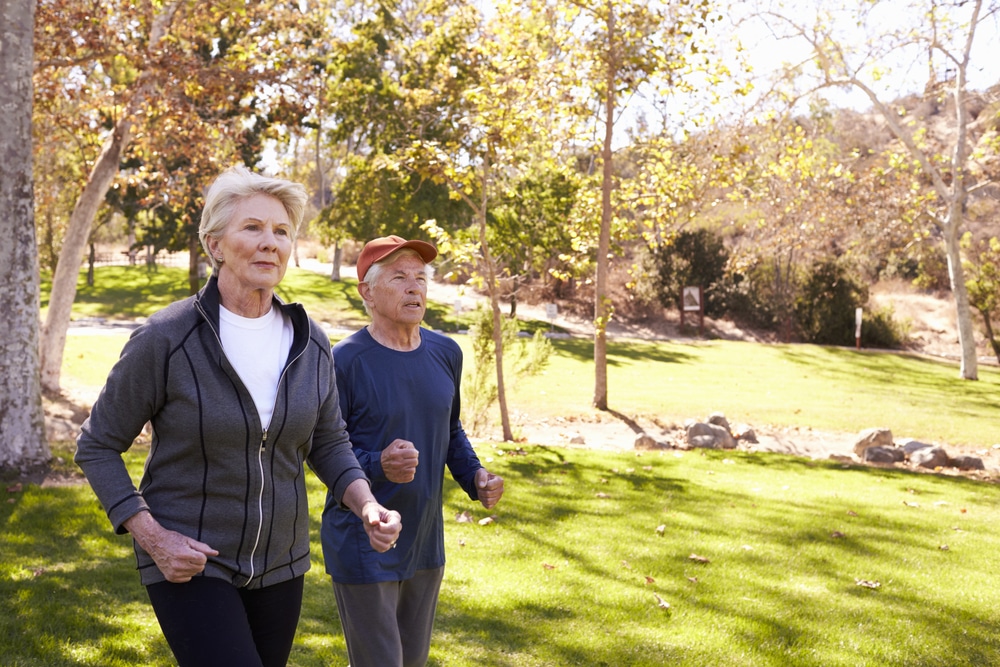 Photo Credit: Shutterstock
Photo Credit: Shutterstock
With countless studies proving the health benefits of power walking, learning how to do it will keep you moving well into the future.
Power walking is one of the most maintainable workouts a person can add to their life, so if you haven’t tried it yet, how about starting now?
Power Walking For Beginners
Yoga For Beginners | A Complete Guide To Get Started  Photo Credit: Shutterstock
Photo Credit: Shutterstock
If you’ve wanted to begin yoga but don’t know where to start, have no fear! This yoga for beginners guide has everything you need to succeed.
Learn the different types and benefits of yoga, as well as guidance on how to get started and choose the practice that works best for you!
Yoga For Beginners | A Complete Guide To Get Started
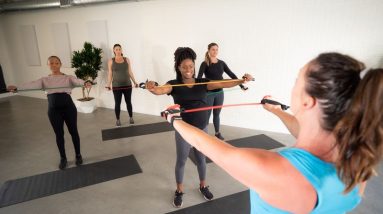
10 Reasons to Get Certified in Prenatal and Postnatal Fitness: Empowering Moms
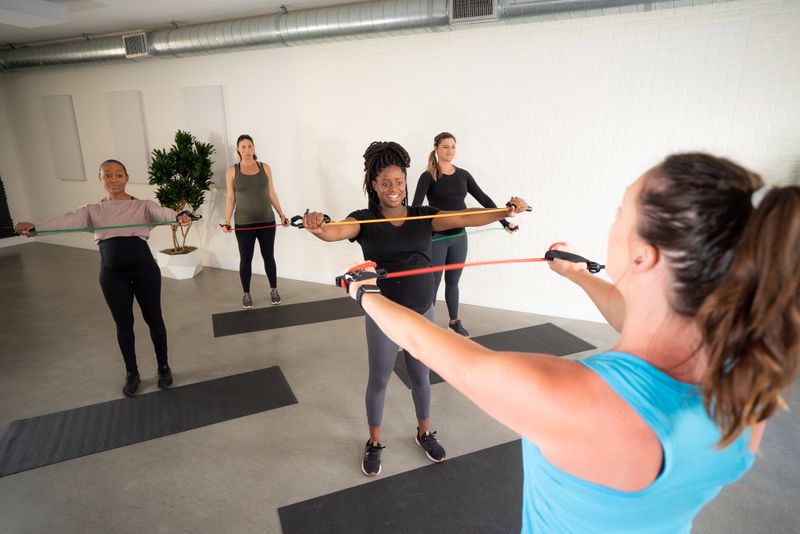
Bringing new life into the world is a miraculous and life-altering experience. Still, it’s no secret that pregnancy and postpartum can bring a whirlwind of changes to a woman’s body. As a fitness professional or health enthusiast, you have the power to support and empower mothers on their journey to a healthy pregnancy, a smoother birth experience, and a robust postpartum recovery. How can you equip yourself with the knowledge and skills to provide the best care and guidance? The answer lies in becoming prenatal and postnatal certified!
In this blog, we will delve into ten compelling reasons why getting prenatal and postnatal certified is not just a valuable addition to your credentials, but a way to make a significant difference in the lives of expectant and new mothers. Whether you’re a fitness trainer, yoga instructor, healthcare provider, or someone passionate about women’s health, the FIT4MOM prenatal and postnatal fitness certification opens the door to a world of possibilities and positive impact!
Let’s dive in, Mama.

